How Much Does It Cost To Start Dropshipping in 2025?
I'm looking for...
Wondering how much does it cost to start dropshipping in 2025?
This guide breaks down all startup costs—from tools to ads—so you can plan smart, avoid overspending, and launch your store confidently.
Create Your Online Store in just 5 Minutes – For Free
Pick your niche, our AI builds your store, add 10 winning products and we teach you how start selling today. Start picking your niche
What You’ll Learn:
Cost Breakdown for Dropshipping Business:
How Much Does It Cost To Start Dropshipping in 2025?
How much does it cost to start dropshipping actually does not have one straightforward answer. Why? Well, there’s a cost structure to follow!
Understanding the financial aspects of the dropshipping business model, including the role of a dropshipping company, is crucial. So, here’s how it goes in most cases.
How To Start Dropshipping With Minimum Budget:
| Expense | Cost Range (Minimum) |
|---|---|
| Business Registration and Licensing Fees | $50 – $100 |
| Website Builder | $15 – $32/month |
| Domain Registration and Hosting | $10 – $20/month |
| Marketing Costs | $100 – $200 |
| Dropshipping Tools | $0 – $29/month |
| Supplier Fees | $0 – $50/month |
| Shipping Costs (for sample products or faster shipping) | $10 – $50 |
| Payment Processor Fees | 2.9% + $0.30 per transaction |
| Hidden & Operational Costs | $20 – $60 |
Total Estimated Minimum Cost: Approximately $330 – $460
On the other hand, here’s the maximum cost to start dropshipping:
| Expense | Cost Range (Maximum) |
|---|---|
| Business Registration and Licensing Fees | $100 – $400 |
| Website Builder (Advanced Plans) | $105 – $399/month |
| Domain Registration | $50/year |
| Hosting (High Performance) | $100 – $200/month |
| Marketing (Aggressive Campaigns) | $500 – $1,500 |
| Dropshipping Tools (Premium) | $50 – $500/month |
| Supplier Fees | $50 – $100/month |
| Shipping Samples | $50 – $200 |
| Payment Processor Fees | 2.4% – 2.9% + $0.30 per transaction |
| Hidden & Operational Costs | $100 – $400+ |
Now, here’s the total range to start Dropshipping based on my calculations.
- Minimum Total: $330 – $460
This includes minimal costs for each essential component, focusing on budget-friendly options for hosting, ads, and tools. - Maximum Total: $1,600 – $3,700+
This is the maximum range, accounting for higher-tier website builders, hosting plans, ad spend, and premium dropshipping tools.
However, If you don’t spend your money carefully, running a dropshipping business might be expensive.
The question is how much knowledge you have regarding the costs you may expect. If you do not obtain enough information before beginning dropshipping, your budget will quickly run out.
📦 Dropshipping Profit Calculator
Learn How To Start An Online Store Without Inventory In 2025.
Most Essential Dropshipping Startup Costs in 2025
Includes LLC registration, EIN (free), and local business licenses.
Tools like Shopify, Wix, Squarespace, and WordPress options.
Depends on domain provider and hosting tier (e.g. GoDaddy, Bluehost).
Includes Facebook, Instagram, TikTok Ads, SEO tools, influencer campaigns.
Examples: AutoDS, DSers, Spocket, inventory/order management tools.
Some suppliers charge monthly fees for access or integration.
Varies by carrier, country, and speed (DHL, FedEx, Amazon FBA).
Applies to PayPal, Stripe, Shopify Payments, etc.
1. Business Registration and Licensing Fees
Even if you’re just starting a dropshipping business as a side hustle, registering your business provides legal protection and builds trust with your customers.
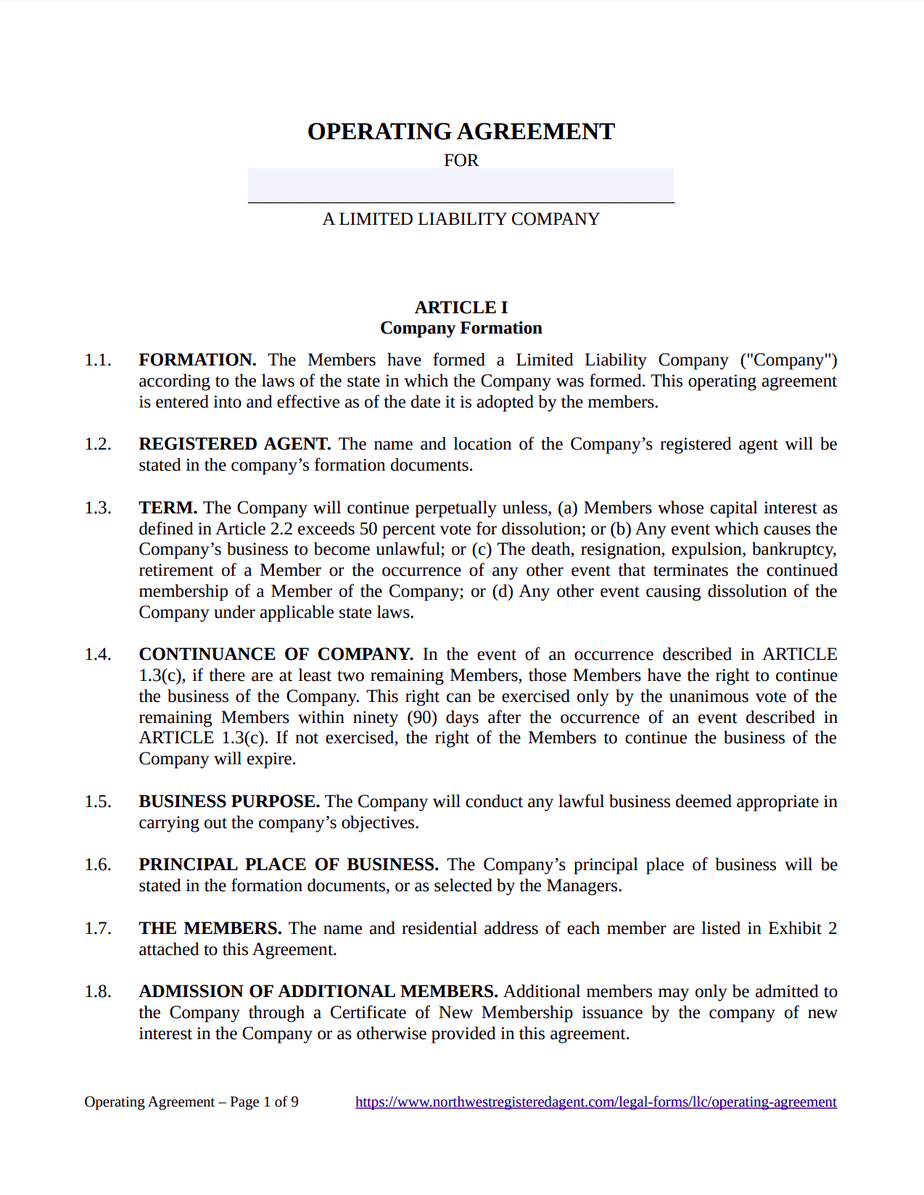
- Business Registration: Filing for an LLC or another entity may cost between $50 and $400, depending on your state.
- Federal Tax ID (EIN): This is free and allows you to open a bank account, apply for licenses, and handle sales tax.
- Business License: Required for some states, and fees typically range from $50 to $200.
So, I recommend you research what licenses you need based on your location and business structure. Most dropshipping suppliers require this step for legal purposes. Additionally, understanding when you need to pay sales tax is crucial, as it varies by state and may require consulting a tax specialist.
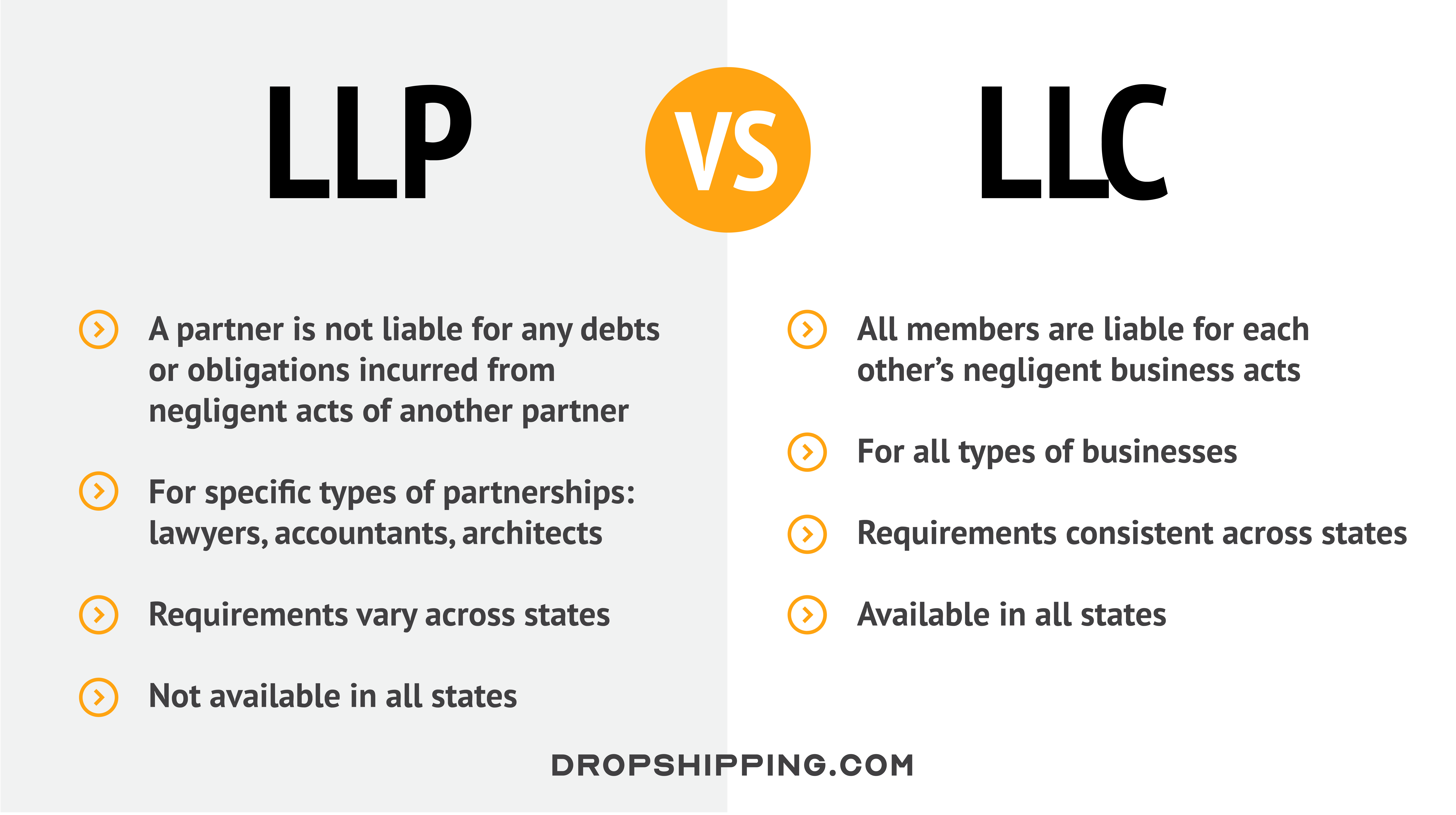
2. Building a Dropshipping Store
You have multiple choices when it comes to building your dropshipping store, like
- Hire a website developer to build it for you, which can cost you a lot. Let’s say it can cost you from $500 to over $2000, or maybe more.
- On the other hand, to create a website from scratch using just an open-source content management system (CMS) such as WordPress can cost you from $100 to $500 to $2000, or even more, depending on your needs.
- Use a website builder, which might be your best choice as a beginner since it is cheaper than all other options. There are various website builders you can choose from depending on your needs and budget, they are very affordable. So, this will cost you from $15 to $400, depending on your needs.
👉 Learn What Is Blind Dropshipping + Step-By-Step Guide To Start Today.
For example, in my opinion, Shopify is the best option. It’s easy to use and offers lots of good-looking themes for dropshipping stores.
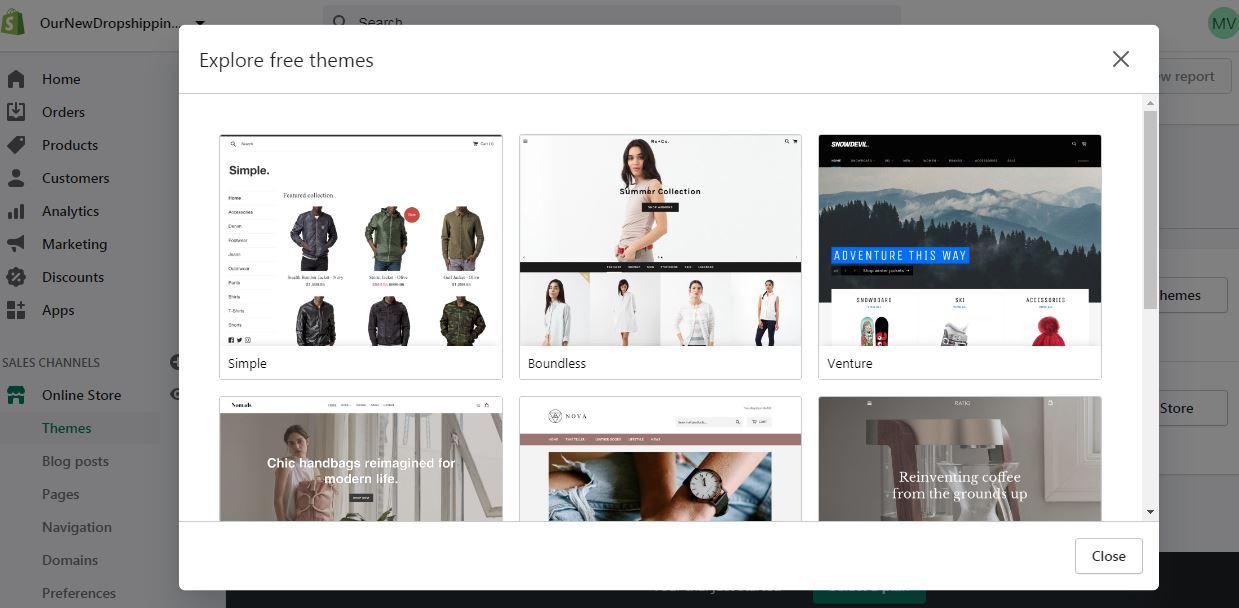
And with their drag-and-drop editor, you can easily make and change your store.
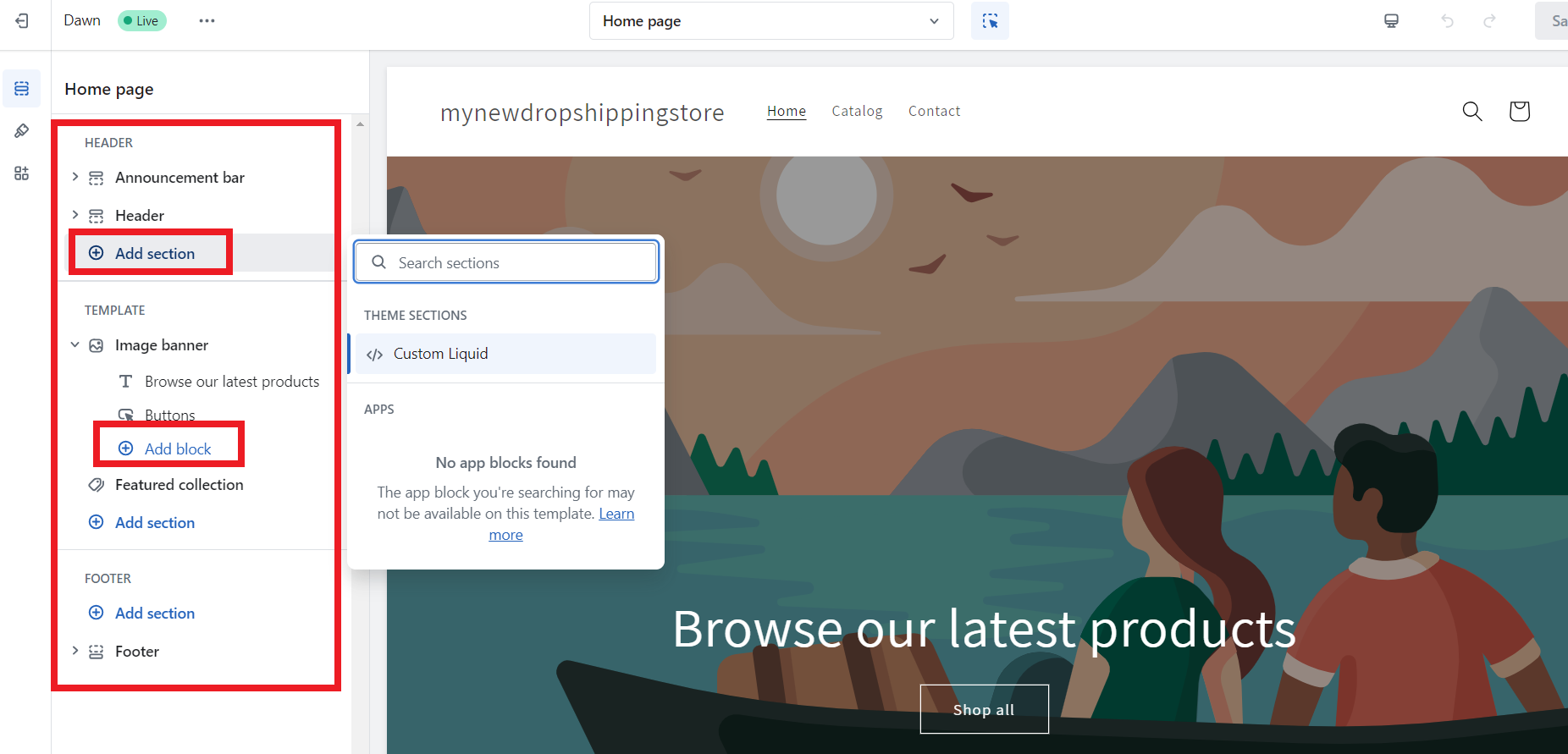
Moreover, Shopify works well with different dropshipping apps, ensuring your business runs smoothly. Plus, you can start for free with their 14-day free trial.
Moreover, this website builder has pricing plans starting at $32/month and up to $2,300/month. So, you can choose what best suits your needs.
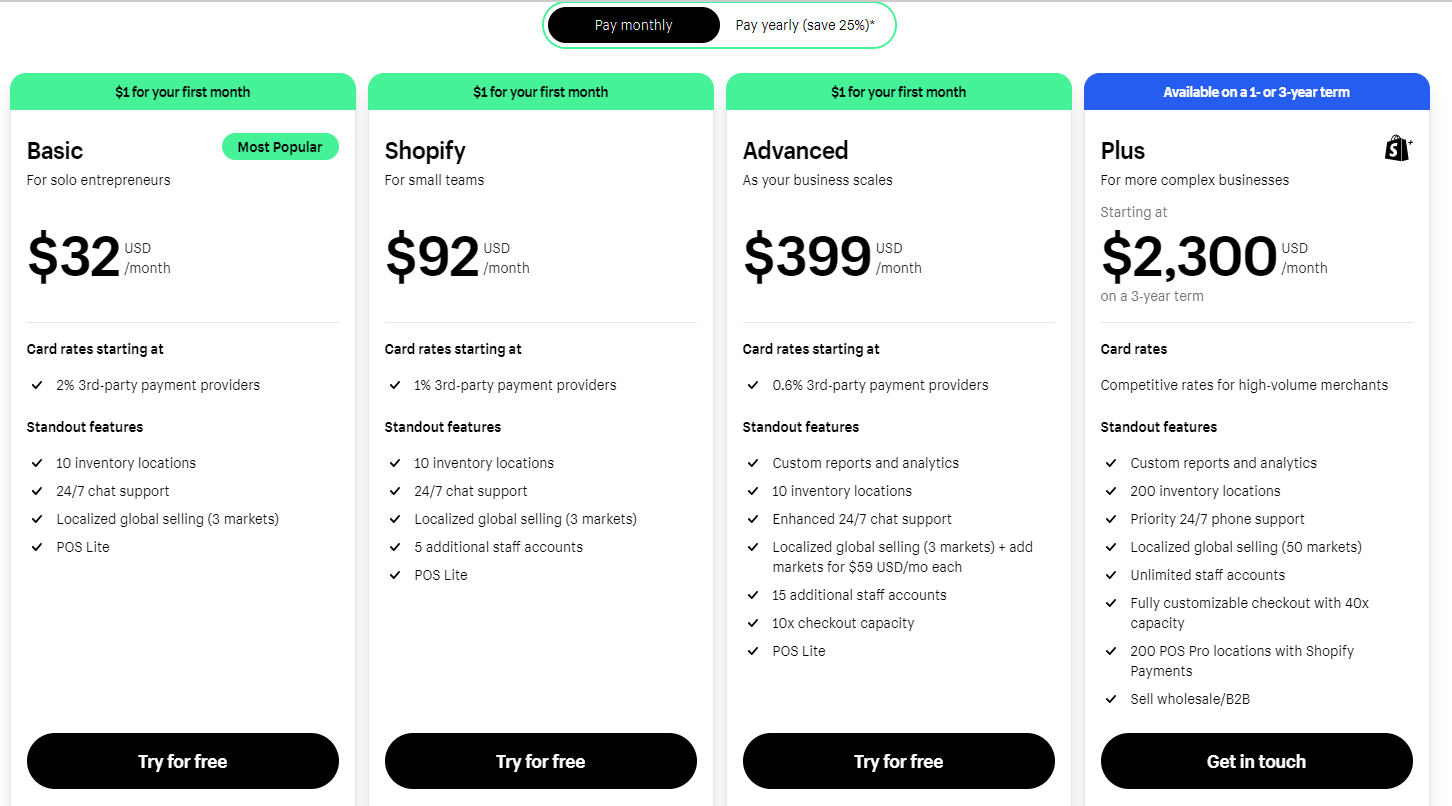
Also, here are some other options:
| Platform | Features | Pricing | Limitations |
|---|---|---|---|
| WooCommerce | WordPress integration, customizable themes, large plugin selection | Free plugin, but costs for hosting and extensions | Requires more hands-on management, additional costs for important extensions |
| BigCommerce | Customizable templates, SEO tools, multi-channel selling integration | Starts at $39/month with no additional transaction fees | Free themes difficult to edit, no multi-language support |
| Squarespace | 100+ templates, eCommerce features, SEO tools, 24/7 customer support | Plans start at $12/month | Limited app store, no free plan available |
| Wix | 500+ customizable templates, drag-and-drop functionality, built-in SEO tools | Plans start at $17/month | Limited dropshipping tools, no stock management alerts |
| Magento (Adobe Commerce) | Open-source, fully customizable, advanced eCommerce tools | Free as an open-source platform, but additional costs for hosting and extensions | Requires technical skills or a developer, can be costly |
| Shift4Shop | Built-in SEO tools, customizable themes, Facebook Store integration | Starts at $29/month, free if processing over $1000/month via Shift4 | Free plan requires minimum sales volume, limited free themes |
3. Domain Registration and Hosting
Having your own custom domain and reliable hosting is essential to building a successful dropshipping business. Also, hosting is a service that provides you with resources to maintain your site and makes it accessible on the World Wide Web.
So, when it comes to how much it costs to start dropshipping, this one is important to calculate.
- Domain Registrar Costs: Domain names generally cost around $10 to $50/year, depending on your choice of domain registrar.
- Hosting Costs: These vary depending on the provider and plan, with prices ranging from $2.95/month to $20+. For instance, Bluehost offers plans starting at $2.95/month.
💡 Pro tip: Be mindful of monthly hosting fees. Some providers offer low introductory prices, but the costs might increase after the first year.
Next, you must obtain a domain that demonstrates your website’s reliability and trustworthiness.
Most of the domains will cost you around $10 in the first year, but keep in mind that this cost might increase after the first year.
For example, on GoDaddy, prices start from £6.84* /1st yr for .com. As for other domains, here are some examples:
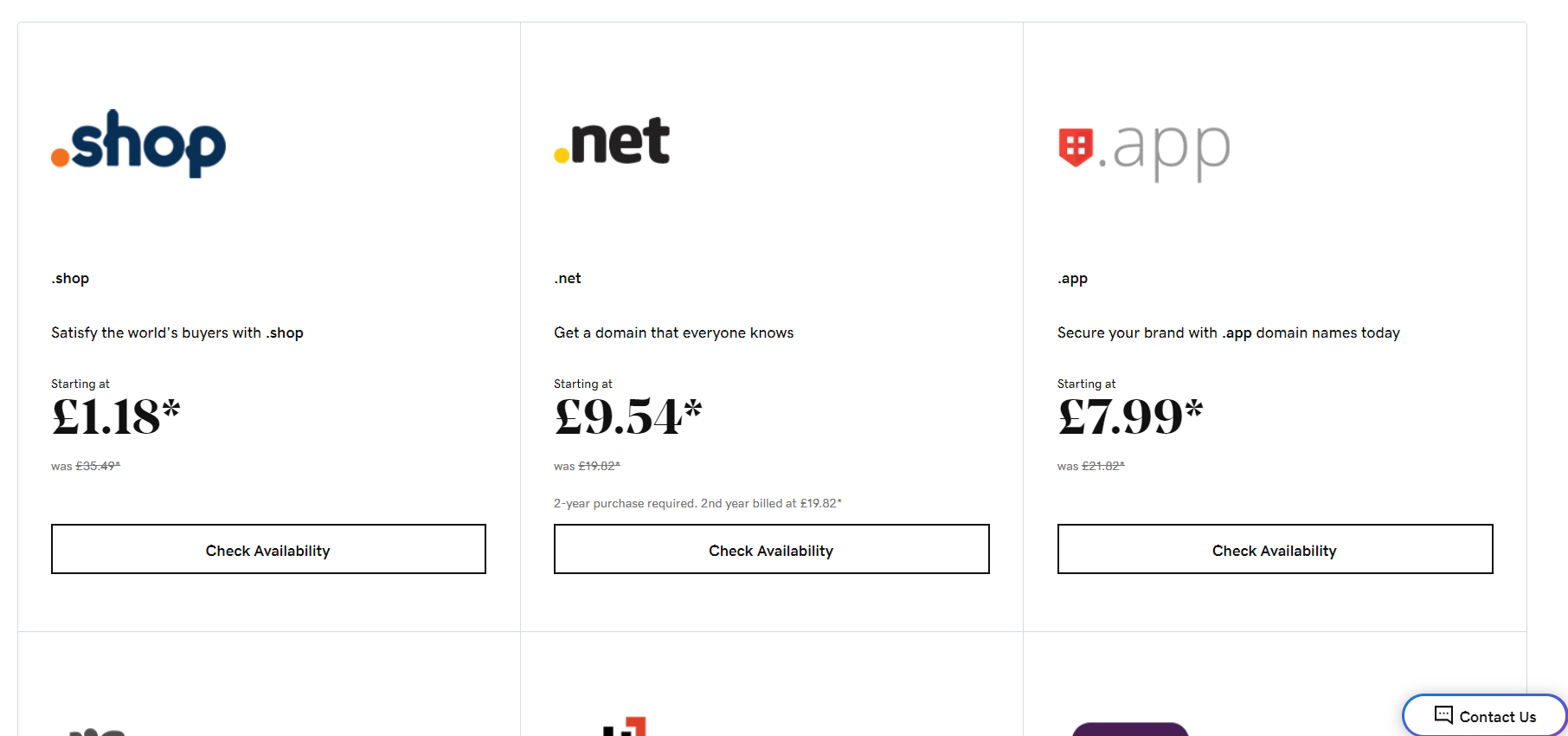
Check out The 8 Best GoDaddy Alternatives For E-Shop Hosting In 2025.
For instance, you can try Bluehost for hosting services. Its primary advantage is exactly the affordable prices. Hence, for hosting they offer pricing tiers starting from $2.95/month.
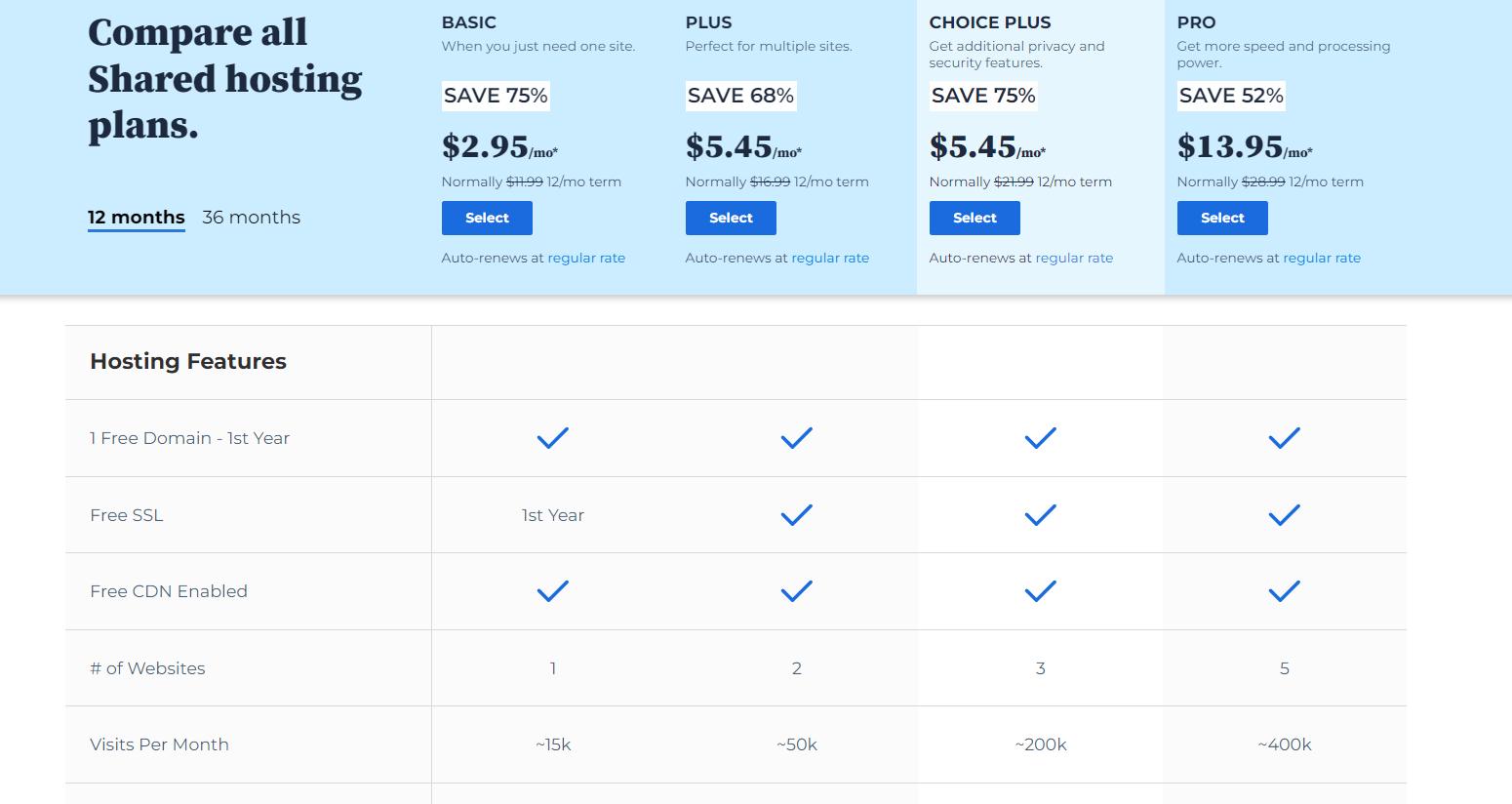
Here are some extra examples:
| Service Provider | Domain Registration Cost | Web Hosting Cost |
|---|---|---|
| GoDaddy | $11.99 | Starting at $2.99/month |
| Bluehost | $12.99 | Starting at $2.95/month |
| Hostinger | $9.99 | Starting at $1.99/month |
| IONOS | $1 for the first year | Starting at $1/month |
4. Marketing Costs
One of the most significant business expenses for a dropshipping store is marketing. So, let’s break down some of the advertising expenses and other marketing costs you should consider:
Paid Advertising (Facebook, Instagram, TikTok)
You’ll likely need to invest in paid ads on social media to attract customers. So, platforms like Facebook Ads, Instagram, and TikTok offer robust targeting options for store owners.
Here’s a rough estimate of ad spending for each platform in 2025:
| Metric | Facebook & Instagram |
|---|---|
| Average CPM (Cost per 1,000 impressions) | $7.75 – $8.96 |
| Average CPC (Cost per Click) | $0.26 – $0.90 |
| Average Cost per Link Click | $0.90 |
| Average Click-Through Rate (CTR) | 0.86% |
| Minimum Weekly Budget | $7 – $70 |
For instance, Facebook ads or Instagram Ads start with at least $1 up to $1000 for per ad, or at least $100 to $200 for initial ad campaigns.
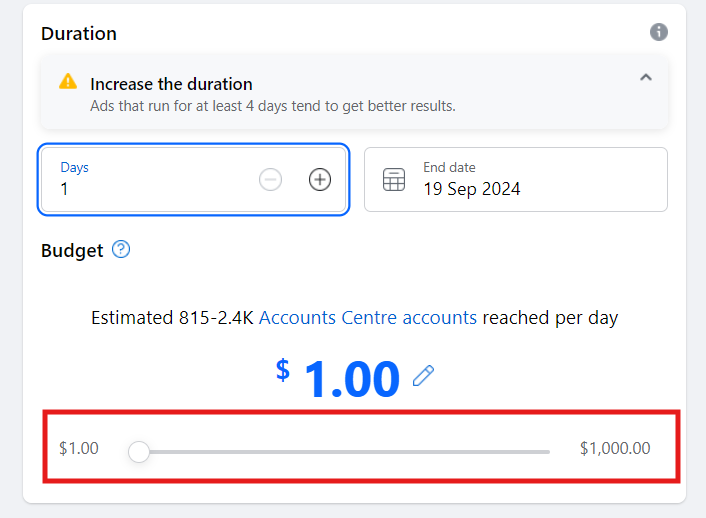
On the other hand, TikTok Ads may require $50 to $100 for a trial period, but viral content can lower costs significantly.
However, if you’re starting on a budget, I advise you to use a small ad spend to test which platforms drive the most potential customers to your store.
Influencer Marketing
Influencer marketing can help you gain traction quickly, especially on visual platforms like Instagram or TikTok. Here’s what to expect:
- Nano Influencers (1,000 to 10,000 followers): Costs range from $100 to $800 per post.
- Mega Influencers (1M+ followers): Costs can go up to $7,000 or more per post, but the reach and engagement are much higher.
Search Engine Optimization (SEO)
SEO is a powerful strategy to generate organic traffic without constantly paying for ads.
By optimizing your ecommerce site for relevant keywords, you can increase visibility on Google and other search engines, which helps drive long-term sales.
Today numerous SEO Tools can help you with SEO and driving traffic.In fact, on the Shopify app store, there are currently 853 SEO tools.

These tools help you find keywords, track rankings, and analyze competitors. Also, their prices range from $15 to $199+ per month.
If you’re using platforms like Shopify or WordPress, SEO plugins like Yoast SEO (WordPress) or Plug–in SEO (Shopify) can cost between $0 and $30/month.
Email Marketing
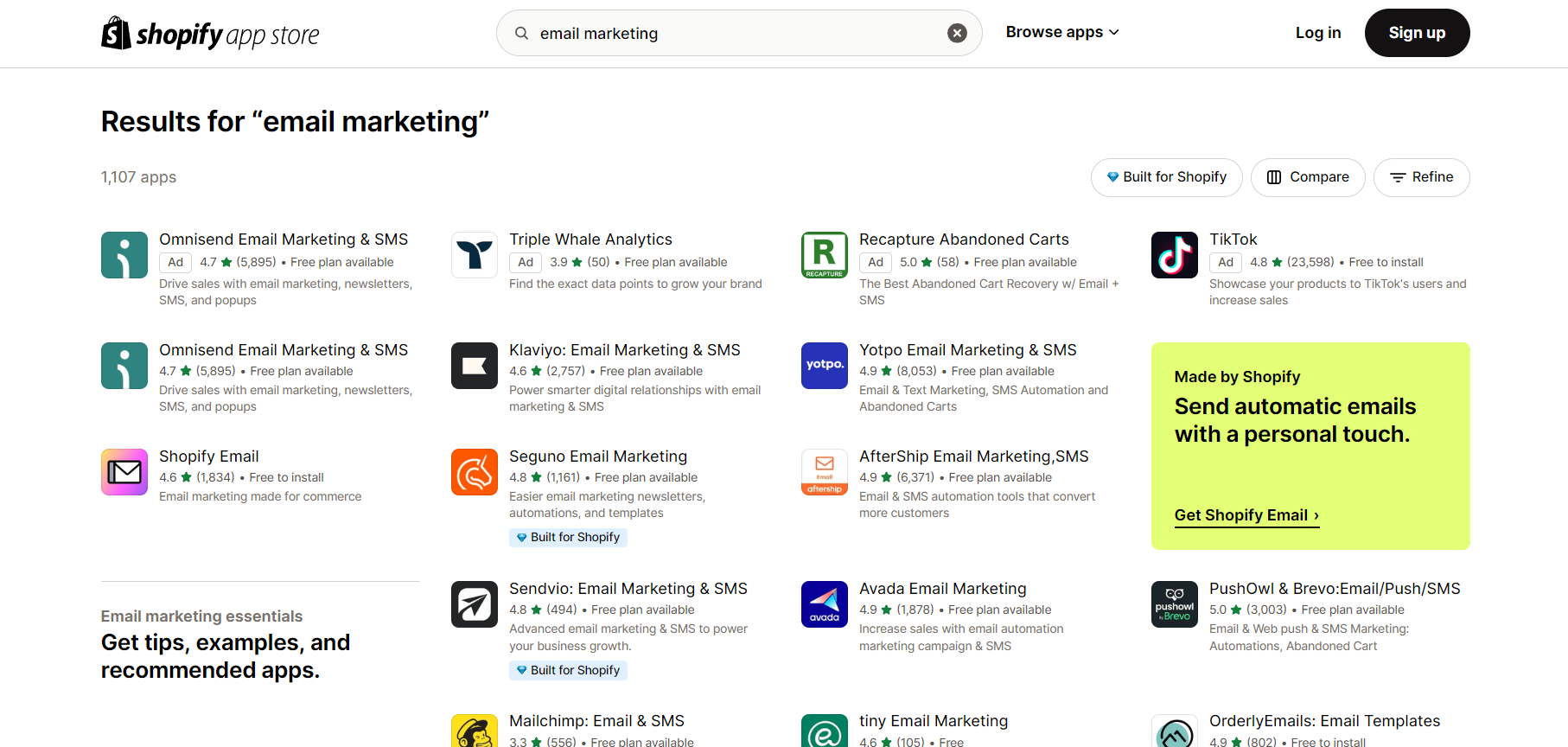
Building and nurturing an email list can deliver a high ROI over time. Here’s what you should consider:
Also, you have various email marketing services to automate this process. Some of them are Mailchimp, ActiveCampaign, Klaviyo, and many more.
Also, the monthly fees range from $10 to $50, depending on the size of your email list and the features you need.
I highly suggest you use email marketing to promote new products, special offers, and content, which can significantly boost repeat purchases.
Content Marketing
Content marketing, like maintaining a blog on your ecommerce site, can drive organic traffic and help establish your brand as a trusted authority in your niche.
So, if you want to maintain the traffic to your website, I suggest you start a blog and write. Or, if you have no time – hire a content writer.
For example, you can create a blog that answers common questions about your niche or provides useful information. This can improve your SEO rankings while offering value to your customers.
However, keep in mind that hiring a content creator can cost you between $30 and $500 per article.
Also, if you plan on publishing regular blog posts or social content, tools like Trello or Airtable help you manage content efficiently for around $10 to $25/month.
Affiliate Marketing
If you’re looking to expand your marketing strategy further, affiliate marketing is an option where you pay commission to affiliates who bring traffic and sales to your store.
Setting up an affiliate program on platforms like Shopify or WordPress could range from $30 to $100 per month, plus commission fees (usually 5-30% per sale).
💡 Tip: Read about The Power Of Product Advertisement: How To Increase Your Sales?
5. Dropshipping Tools
A dropshipping tool acts as a link between your business and your suppliers. The tool not only aids you in managing your goods and importing them into your dropshipping store but it also assists you in placing orders with your suppliers and synchronizing their status.
A decent dropshipping tool can undoubtedly save you a lot of time and effort while operating your dropshipping store. As a result, we strongly advise you to select one carefully.
Various dropshipping tools are pretty affordable. For instance, on the Shopify App Store, you can find dropshipping apps that cost as low as $1 to $5, and up to hundreds of dollars. Also, there are apps that are even free.
Not only that, but the platform has apps and tools to connect with dropshipping suppliers for Shopify.
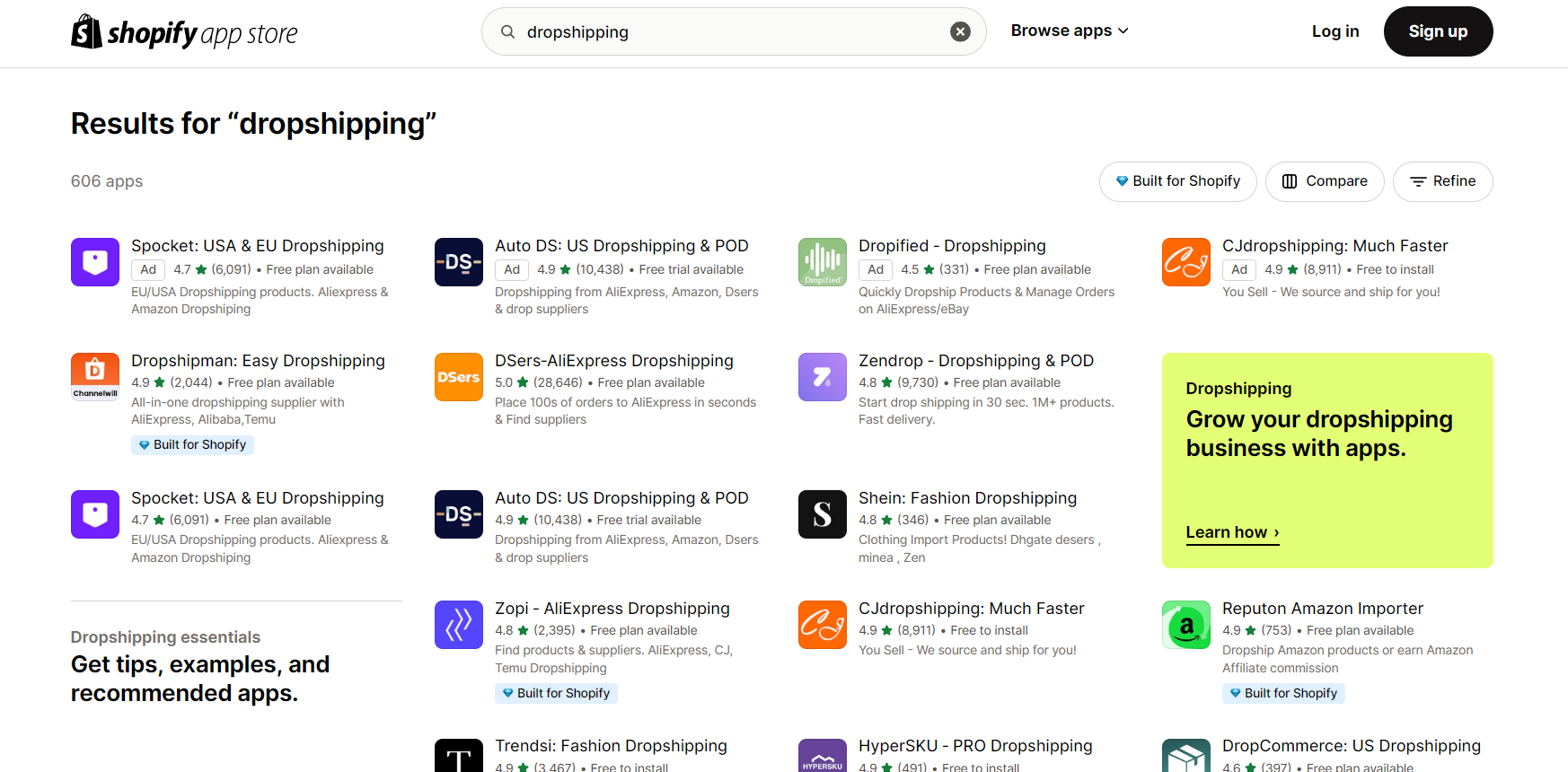
However, keep in mind that this is MUST for your business. Hence, you will need apps for product import, inventory management, order fulfillment, and more.
For example, I am personally using AutoDS. This tool has a very affordable and optional pricing structure, depending on your selling channel. So, since I am using Shopify, in my case AutoDS costs from $19.90 to $49.90.
Now, let’s see how much does it cost to start dropshipping with a minimum budget.
6. Supplier Fees
Most dropshipping suppliers charge additional fees beyond just the product price, especially for premium features or integrations.
These fees can vary depending on the supplier and the services they offer.
Some suppliers charge a monthly fee for access to their products or special services. For example, Zendrop offers a free plan, but the Pro plan costs $49/month, which includes features like faster shipping, branded invoicing, and access to US-based suppliers.
On the other hand, SaleHoo costs $27/month for basic access to over 8,000 suppliers, while Worldwide Brands offers lifetime access for $299.
However, keep in mind that certain suppliers charge a small fee for each order placed through their platform, often ranging from $1 to $5 per order. This fee is added on top of the product cost.
Also, if you’re using an external supplier with platforms like Shopify, some suppliers may charge fees to integrate directly with your ecommerce store, allowing for easier automation of order fulfillment.
Starting a dropshipping business has lower upfront costs compared to launching an actual retail store, which requires significant investment.
7. Payment Method Fees
When accepting payments on your dropshipping store, you’ll need to account for fees from various payment processors. However, these fees can vary depending on the provider and the country in which you operate.
So, here’s a list of some of the options you have.
- Shopify Payments: 2.9% + $0.30 per transaction for US-based payments.
- PayPal: 2.9% + $0.30 per transaction, with international fees as high as 4.4%.
- Stripe: 2.9% + $0.30 per transaction, with an additional 1% for international payments.
- Amazon Pay: 2.9% + $0.30 per transaction for US-based payments and 3.9% for international transactions.
- Square: 2.9% + $0.30 for online payments.
8. Shipping and Fulfillment Costs
Shipping is one of the more significant dropshipping costs you’ll encounter when running an online store. Here’s a breakdown of common shipping methods:
FedEx
- FedEx Ground: Ideal for domestic shipping within the US, with costs starting at $7 and delivery times of 1–5 business days.
- FedEx International Economy: Costs vary based on weight, typically ranging from $30 to $100 for international shipments.
DHL
- DHL Express Worldwide: Delivers in 1–3 business days to over 220 countries, making it ideal for global orders. Costs range from $20 to $50.
- DHL eCommerce: A cost-effective option for lighter packages with delivery times of 7–20 days.
Amazon FBA (Fulfillment by Amazon)
If you want to integrate with Amazon FBA, you’ll pay:
- Storage Fees: From $0.69 per cubic foot, with higher fees during peak seasons.
- Fulfillment Fees: Based on item size and weight, typically $2.50 to $5 per item.
9. Taxes and Regulatory Fees
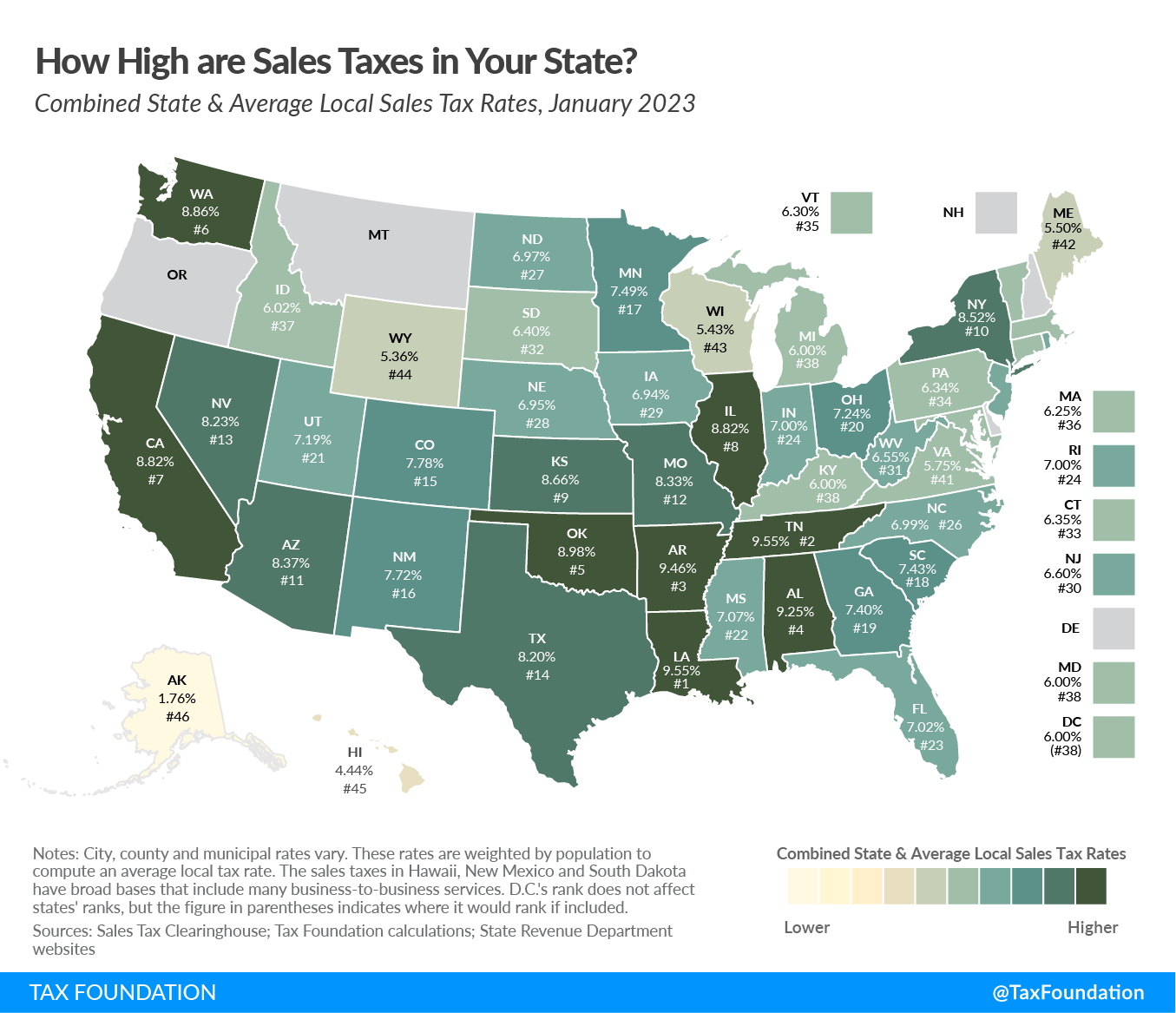
Taxes are unavoidable when running a successful dropshipping business. Here’s what you need to know when it comes to how much it cost to start dropshipping:
- Sales Tax: Varies by state in the US. You’ll need to pay sales tax in states where you have a nexus.
- Value-Added Tax (VAT): Applicable in many countries, ranging from 5% to 27% of the order’s total cost.
- Income Tax: You’ll pay taxes on your dropshipping profits, but you can deduct business expenses like advertising, shipping, and product costs.
💸 Hidden Costs of Dropshipping Most Beginners Overlook
While dropshipping is known for its low startup costs, there are several hidden expenses that often go unnoticed—until they eat into your profit margins.
Let’s uncover what they are so you can plan smarter and stay profitable.
1. Chargebacks and Refunds
When a customer files a chargeback—either because the item didn’t arrive on time, wasn’t as described, or they simply changed their mind—you lose the sale and pay additional fees.
Most payment processors like PayPal and Stripe charge a $15–$25 dispute fee per chargeback, even if you win the case.
2. Currency Conversion and Cross-Border Fees
If your store sells internationally, payment processors may charge 1–2% on top of each transaction for converting currencies. Shopify Payments, Stripe, and PayPal all apply these quietly, which can reduce your net profits over time.
3. App Stack Overload
As your store grows, so does your reliance on Shopify apps or plugins for SEO, upsells, reviews, email automation, and more. What starts as a few tools at $5 to $15/month can quickly climb to $100–$300/month in recurring app fees.
4. Product Testing and Failed Ads
Testing new products means running ad campaigns that may not convert. Many beginners don’t account for these sunk costs, often spending $100 to $500+ testing winning products before finding one that takes off.
5. Packaging and Branding Upgrades
If you want branded invoices, custom packaging, or private-label options, many suppliers charge additional fees or require higher minimum orders. These branding costs might not be visible upfront but are essential for serious ecommerce brands.
6. Longer Shipping = More Refunds
Low-cost suppliers like AliExpress often have longer delivery times. While you save on fulfillment, it can lead to increased refund rates, bad reviews, and lost repeat business—all of which cost more than they seem.
7. Data and Reporting Tool
If you’re using external analytics tools like Triple Whale, BeProfit, or advanced reporting dashboards, expect to pay $20–$100/month to accurately monitor your profit margins, customer LTV, and ROI per product.
8. Inventory Sync and Order Errors
Without proper automation tools, your store can oversell or show out-of-stock items as available. Fixing these errors—either manually or through apps—adds operational burden and often leads to refund requests.
What Is The Minimum Budget To Start Dropshipping in 2025?
Well, let’s see! According to the previously mentioned costs, let’s say that you want to save at the beginning.
| Expense | Cost Range (Minimum) |
|---|---|
| Business Registration & Licensing Fees | $50 – $100 |
| Website Builder | $15 – $32/month |
| Domain Registration & Hosting | $10 – $20/month |
| Marketing Costs | $100 – $200 |
| Dropshipping Tools | $0 – $29/month |
| Supplier Fees | $0 – $50/month |
| Shipping Costs (Samples/Faster Delivery) | $10 – $50 |
| Payment Processor Fees | 2.9% + $0.30 per transaction |
| Hidden & Operational Costs | $20 – $60 |
Note: Hidden costs often include failed product tests, chargebacks, extra Shopify apps, international transaction fees, branding upgrades, and refund processing. Always set aside a flexible budget buffer for these.
You can start dropshipping with a minimal budget if you choose cost-effective tools and shipping methods.
Here’s a breakdown of the minimum upfront costs:
- Website Builder (Shopify Basic Plan): $29/month
- Domain: $10/year
- Hosting: $13/month
- Advertising (Facebook, Instagram): $100
- Supplier Fees (Zendrop/Spocket Free Plan): $1–$50/month
- Dropshipping Tools: $29/month
- Business Registration Fees: $50–$100 (depending on your state)
- Shipping Costs: Using ePacket or similar low-cost shipping methods from suppliers like AliExpress could cost around $3–$7 per order, but to keep it simple for starting costs, budget $50–$100 for shipping.
Total Minimum Budget To Start Dropshipping Calculation:
- Website Builder + Hosting + Domain: $29 + $13 + $10 = $52/month (for ongoing web costs)
- Advertising: $100 (for initial paid ads)
- Supplier Fees + Dropshipping Tools: $50 (for suppliers and tools like Zendrop)
- Business Registration Fees: $50–$100 (depending on your state)
- Shipping Costs: $50–$100 (initial costs to ship a few products)
However, let’s not forget about taxes!
With Sales Tax (Assume 5% for simplicity):
- On purchases like the website builder, domain, and hosting, you’ll pay sales tax. So, as an example, here’s how this would go:
- Sales Tax on $29 (website builder) = $1.45
Sales Tax on $13 (hosting) = $0.65
Sales Tax on $100 (advertising) = $5.00 - Total Sales Tax: $7.10
Minimum Total Cost:
If you’re starting small, expect to spend about $302 to $402 to get started with basic suppliers, shipping, and tools.
Furthermore, let’s learn how much it cost to start dropshipping at its max!
💡 Tip: Learn about Dropship Baby Products: A Step-By-Step Guide + Top 24 Products
What Is The Maximum Amount of Money For Starting Dropshipping?
| Expense | Cost Range (Maximum) |
|---|---|
| Business Registration & Licensing Fees | $100 – $400 |
| Website Builder (Advanced Plans) | $105 – $399/month |
| Domain Registration | $50/year |
| Hosting (High Performance) | $100 – $200/month |
| Marketing (Aggressive Campaigns) | $500 – $1,500 |
| Dropshipping Tools (Premium) | $50 – $500/month |
| Supplier Fees | $50 – $100/month |
| Shipping Samples | $50 – $200 |
| Payment Processor Fees | 2.4% – 2.9% + $0.30 per transaction |
| Hidden & Operational Costs | $100 – $400+ |
You may start selling after spending less money to set up your dropshipping business, but there is always a potential for improvement. Sourcing extra money or reinvesting your sales proceeds might assist you in improving your store’s operations.
So, if you are willing to expand your business, you will probably need to expand your costs too. In this case, let’s say that you will probably want to use a better website theme, more functionalities, etc.
If you’re planning to scale quickly and use premium tools, here’s what your maximum upfront costs could look like:
- Website Builder (Shopify Premium Plan or custom store): $100/month
- Domain: $50/year (for a premium domain)
- Hosting (dedicated plan): $200/month (if you’re opting for high-performance hosting)
- Advertising Budget: $200–$1000 for a more aggressive paid advertising strategy (Facebook/Instagram)
- Supplier Fees (Zendrop Pro Plan or Spocket Premium Plan): $49/month
- Dropshipping Tools (advanced tools like AutoDS): $50–$500/month
- Business Registration Fees: $100–$400 (depending on your state and entity type)
- Shipping Costs: Using FedEx, DHL, or Amazon FBA, budget at least $50–$200 for shipping, especially for faster delivery options and premium suppliers.
Total Maximum Budget:
- Website Builder + Hosting + Domain: $100 + $200 + $50 = $350/month (for ongoing web costs)
- Advertising Budget: $500–$1,500
- Supplier Fees + Dropshipping Tools: $100–$150
- Business Registration Fees: $100–$400 (depending on your state)
- Shipping Costs: $100–$200 (for faster shipping methods like FedEx, DHL, or Amazon FBA)
With Sales Tax (Assume 5% for simplicity) here’s an example calculation:
- Sales Tax on $100 (website builder) = $5
Sales Tax on $50 (domain) = $2.50
Sales Tax on $200 (hosting) = $10
Sales Tax on $500 (advertising) = $25 - Total Sales Tax: $42.50
Maximum Total Cost:
If you’re aiming to scale quickly with premium tools and shipping, your total costs could range from $1,500 to $3,300+.
How To Start Dropshipping With A Minimum Budget or $0 Costs? (My Advice)
1. Identify Your Niche and Products
Starting a dropshipping business involves selecting the right niche and products. How much does it cost to start dropshipping?
This can vary depending on your choices, but you can begin with an extremely small investment if you plan well.
For instance, researching your niche thoroughly is crucial. Look for products with low to medium competition and good profit margins. This approach helps ensure that your startup costs remain manageable while giving you the potential to build a successful business.
Many dropshipping tools, like Sell The Trends, come with free trials that help you explore winning products without upfront costs.
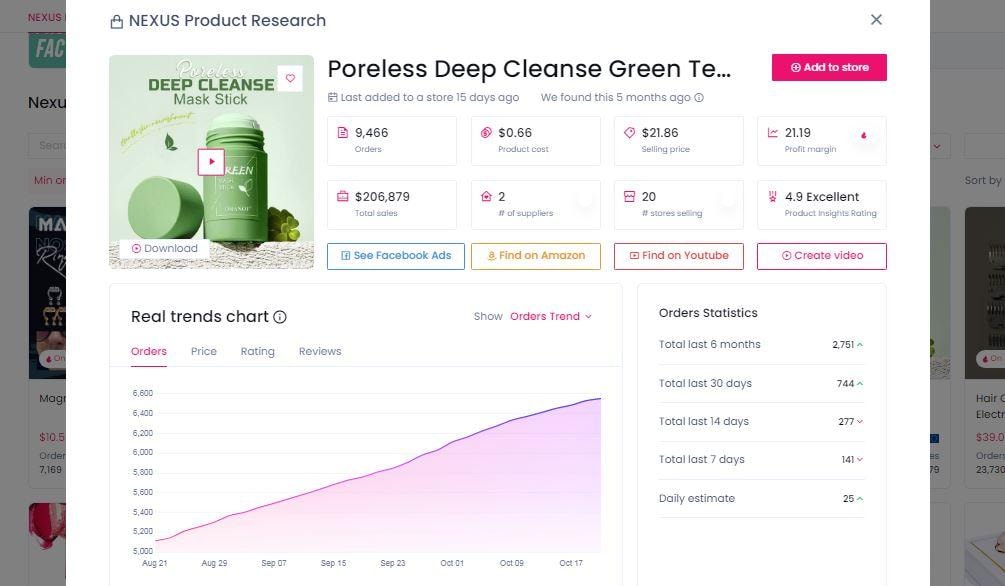
For example, you can use the 7-day free trial to make a list of products with high demand and profit margins and later do in-depth research yourself.
Also, I highly recommend using Google Trends. It’s a completely free tool that lets you check product demand.
For instance, if you’re interested in selling wireless phone chargers, you can search for this term on Google Trends to see how it’s performing globally or in specific countries.
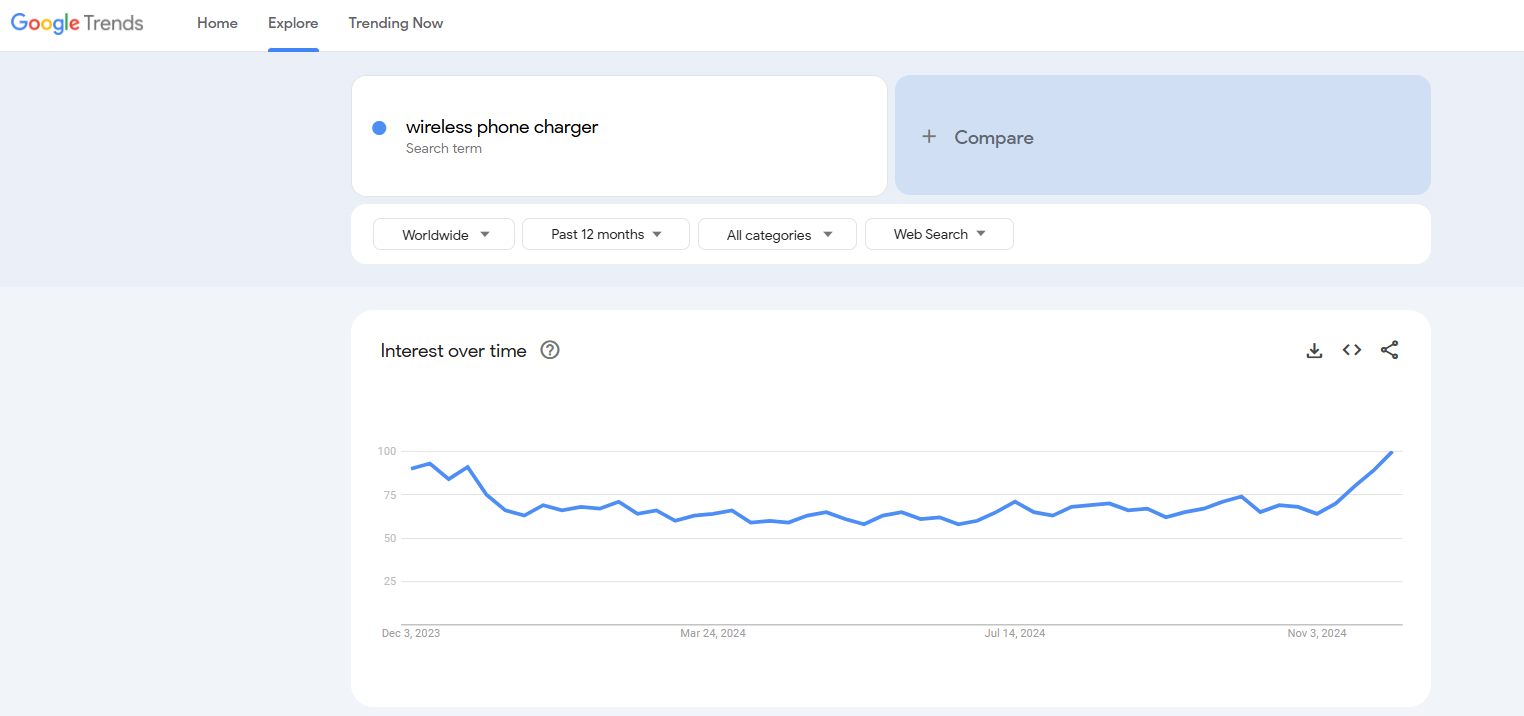
This way, you can align your ecommerce business with what’s trending in the global dropshipping market.
Here’s another idea.
On Amazon Movers & Shakers, you can find out which items have been selling well over the past 24 hours.
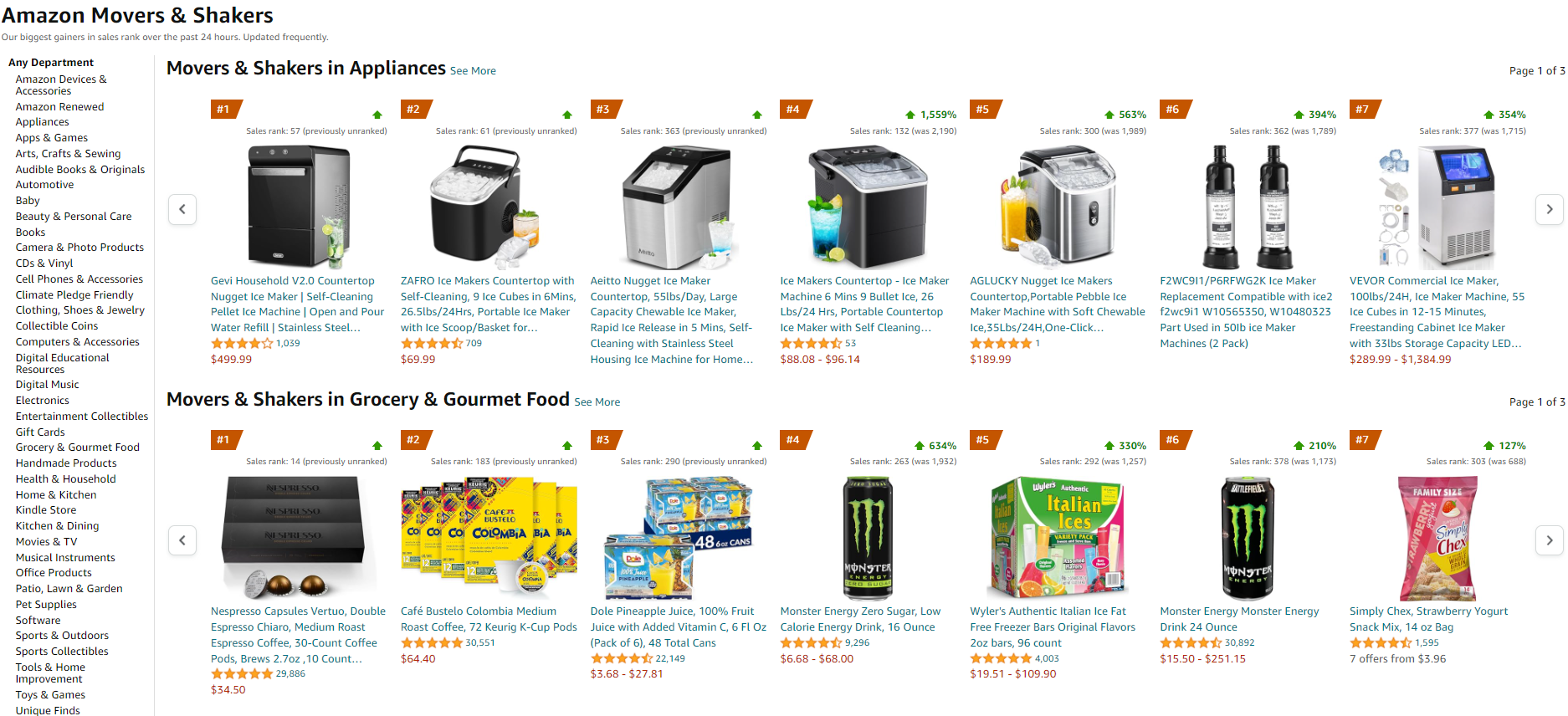
2. Check Product Competitiveness
Once you have some product ideas, it’s important to check their competitiveness. For example, you can use Ahrefs or Semrush to do keyword research.
tools reveal important data like keyword difficulty, search volume, and competitor rankings.
For example, using Semrush, I discovered that scented candles have a low keyword difficulty, meaning it’s easier to rank for this term.
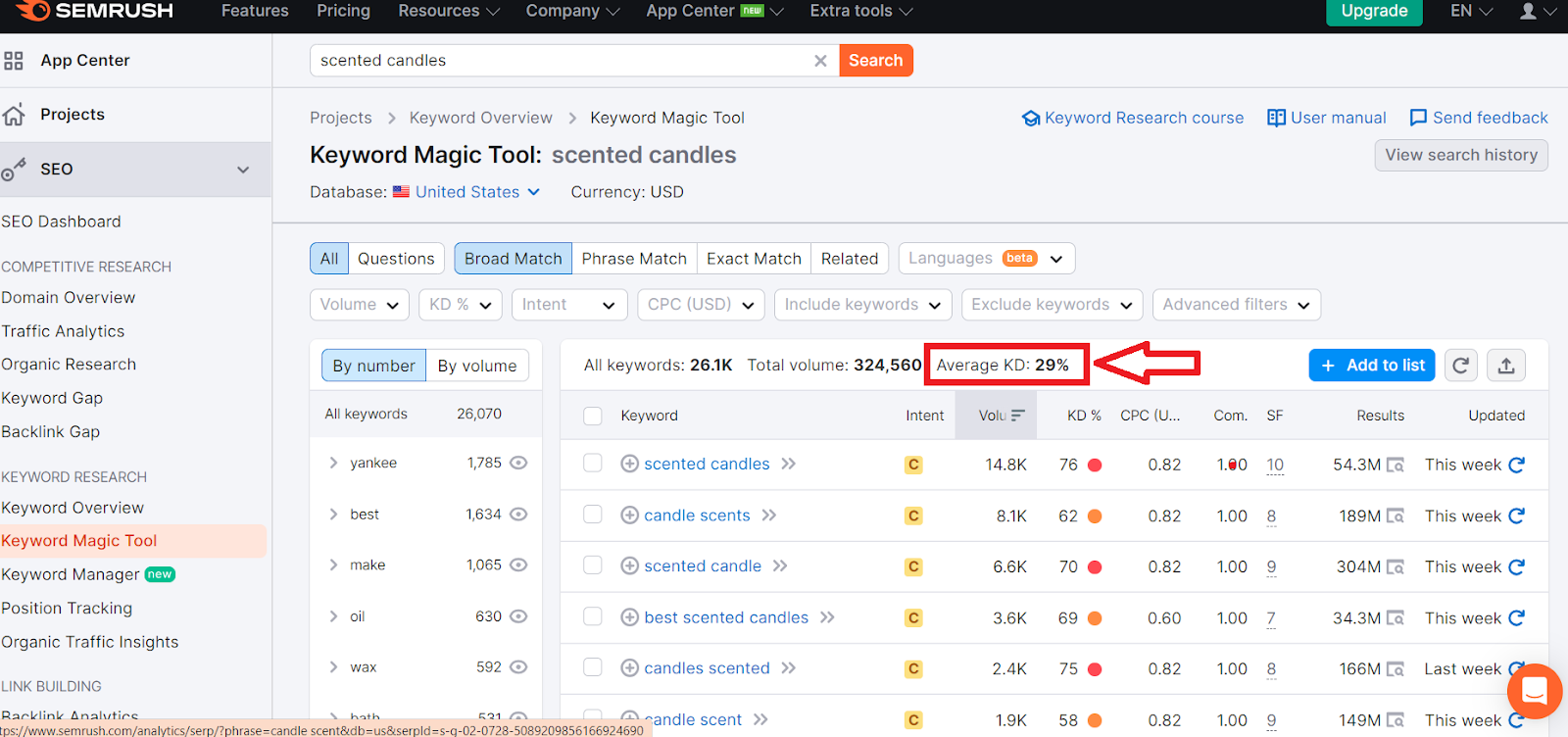
Ahrefsis another great tool that helps you understand your competitors’ best-performing keywords and offers a free trial for beginners who want to explore their niche before investing in paid tools.
3. Find a Reliable Supplier
A dropshipping business cannot function without reliable dropshipping suppliers. Most dropshipping suppliers can be found through free directories, saving you the upfront costs of paid research.
For instance, Dropshipping.com offers a directory where you can search for suppliers based on location, shipping times, and product categories. Plus, it’s all FREE!
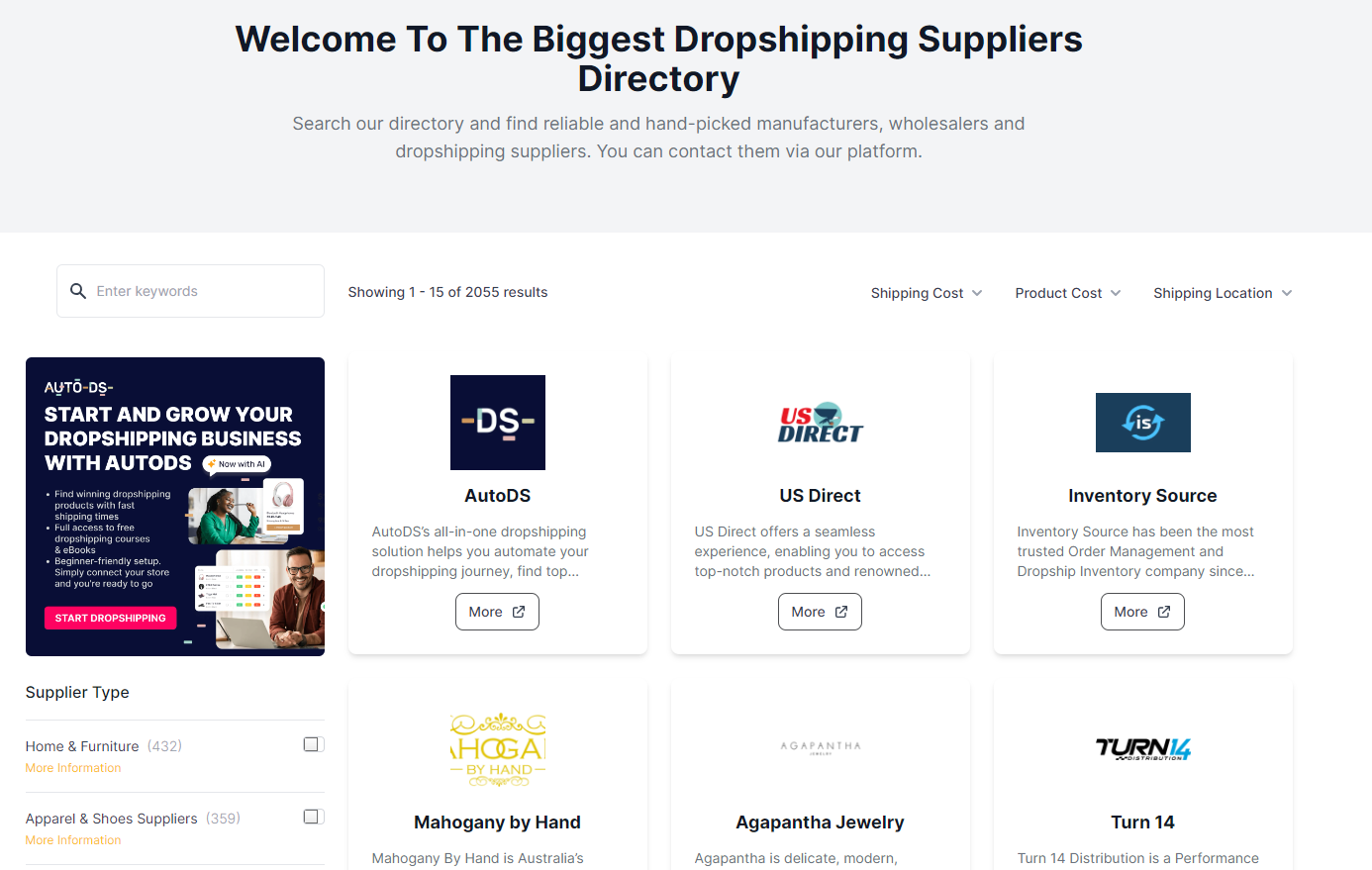
You will get data about product costs, shipping details, average order processing time, location, MOQ, and more.
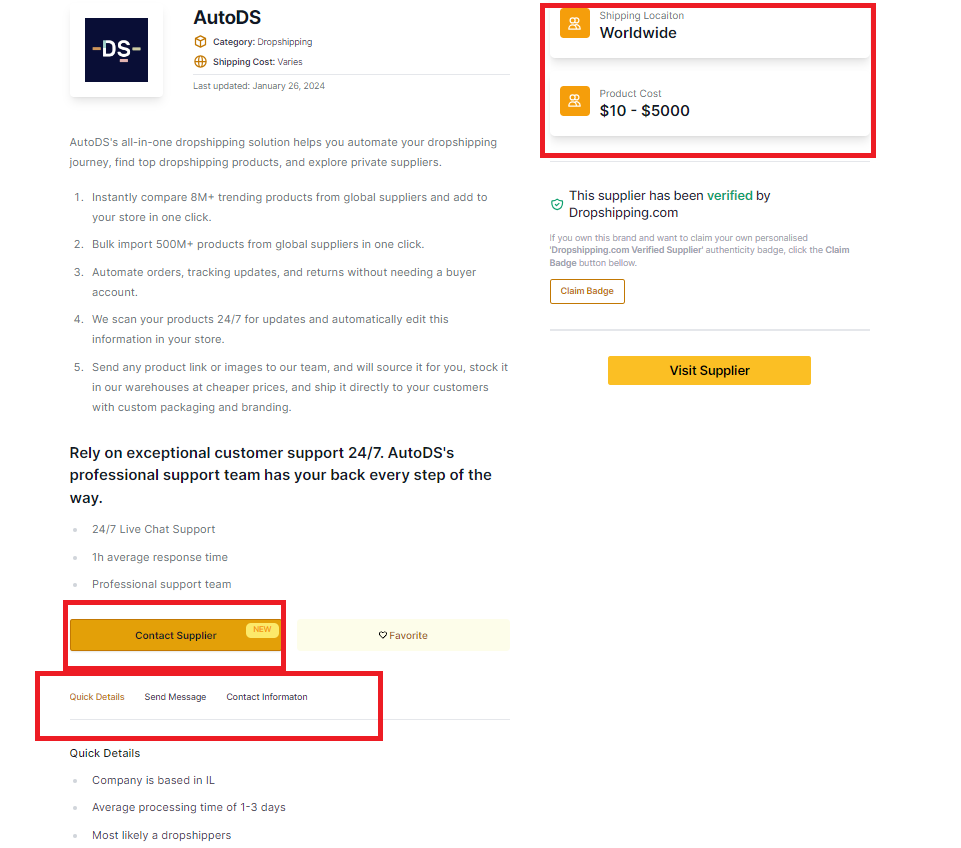
When choosing a supplier, there are several things you should consider. Compare prices to see which supplier is offering affordable rates for your products. If you’re about to start a candle dropshipping business, looking for affordable products and custom candle packaging at wholesale rates will help you save a lot of money.
It’s important to ensure they offer bulk pricing and have a transparent payment processor for easy transactions.
Also, always verify their dropshipping costs to avoid surprises. Some suppliers even offer lifetime access to their catalogs, which can be a huge benefit as your business grows.
4. Set Up Your Free Online Store
Next, you need to set up an online store to sell your products. You can minimize business startup costs by using platforms with free trials.
For example, Shopify offers a 3-day free trial, which allows you to get started without providing any card details.
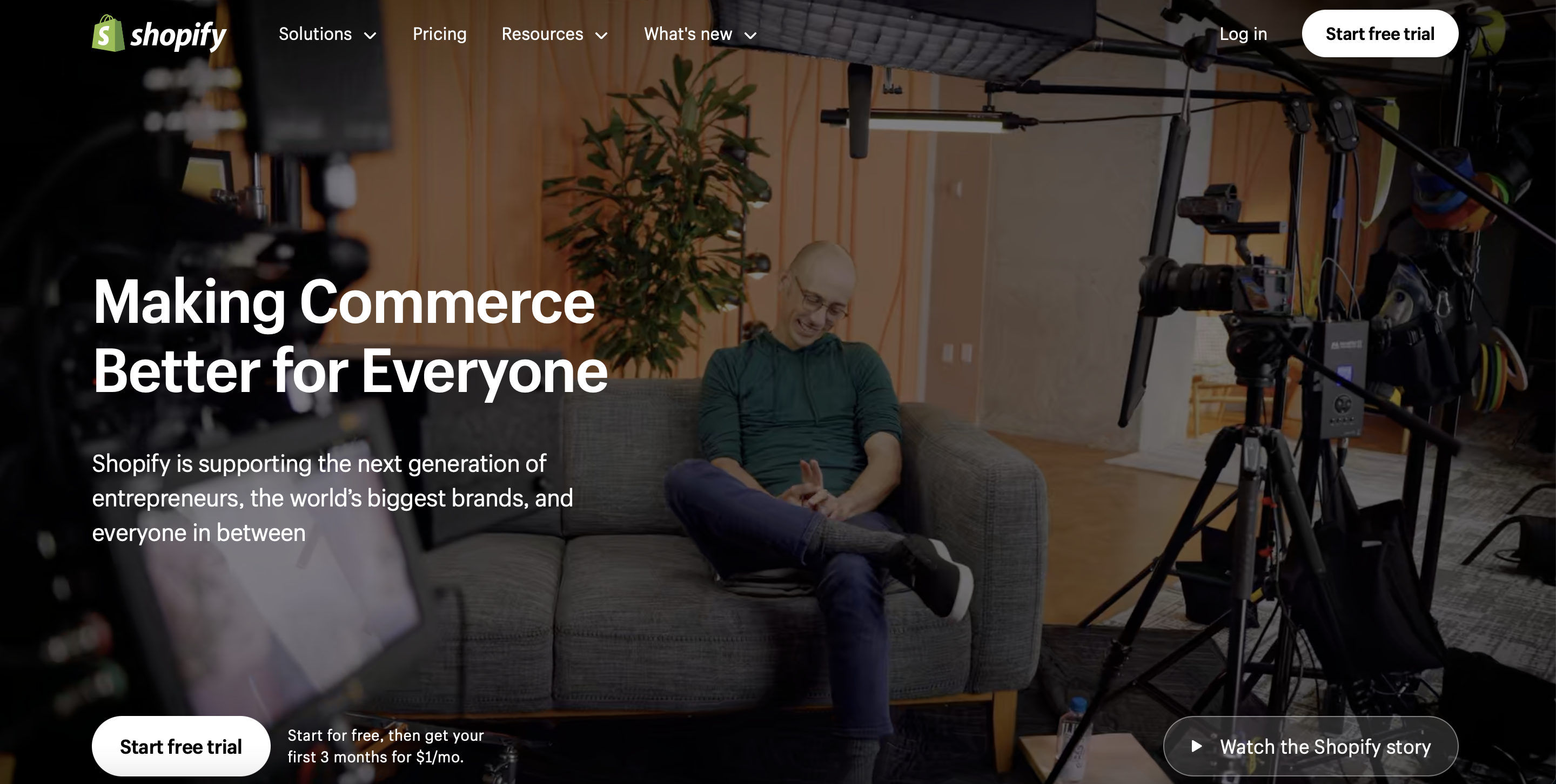
So, you can use the trial to set up your Shopify store, design your ecommerce site, and upload a few products.
After the free trial, Shopify payments start at a monthly fee, but this investment can be minimal if you plan ahead.
If you prefer a completely free option, Google Sites is a good alternative, although it’s not ideal for a successful dropshipping business.
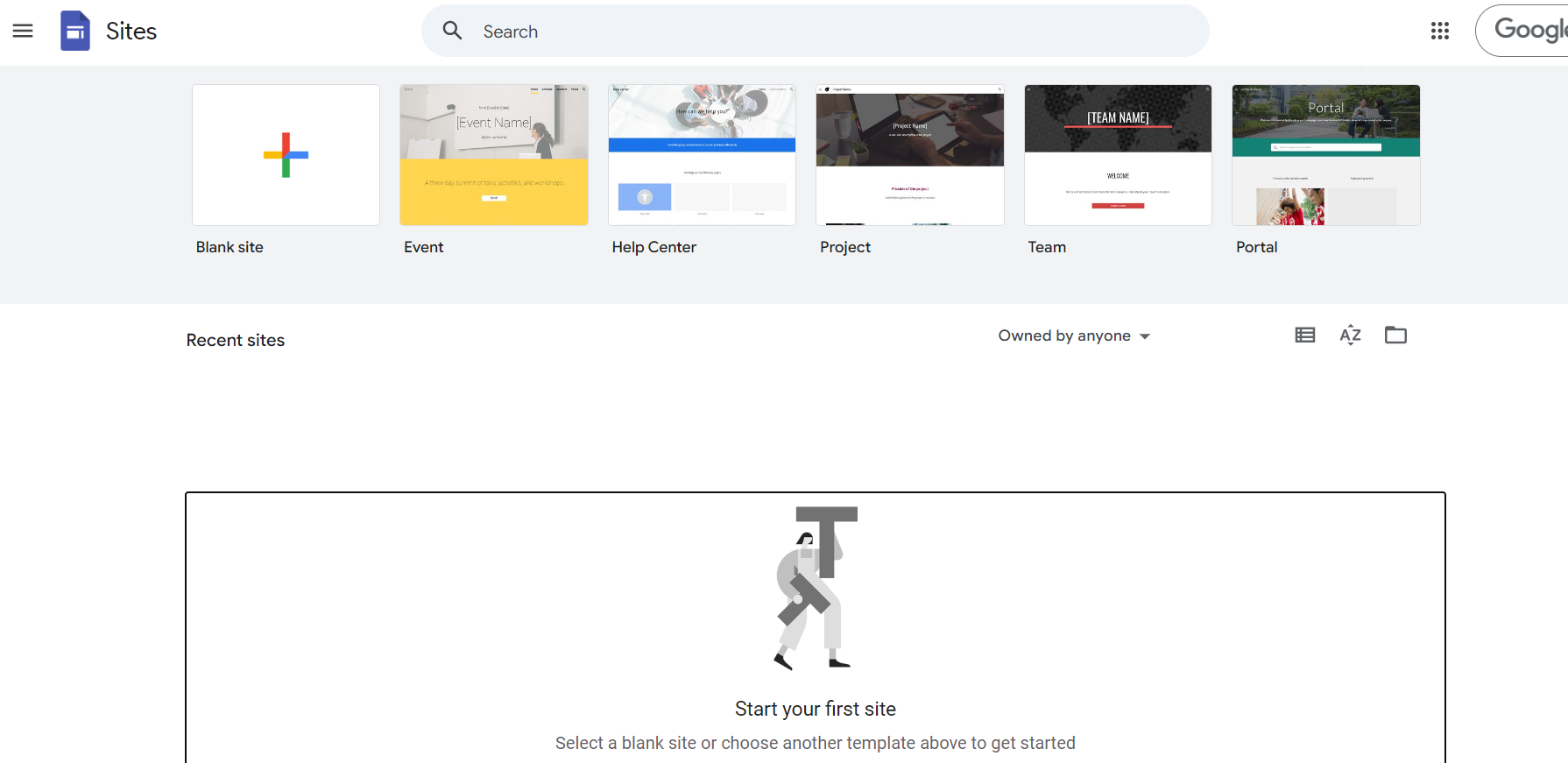
However, I found myself a solution for only $1. DSCOM offers a service to build your AI-Shopify-generated store for only $1.
All you have to do is answer a few questions about your business and that’s it!
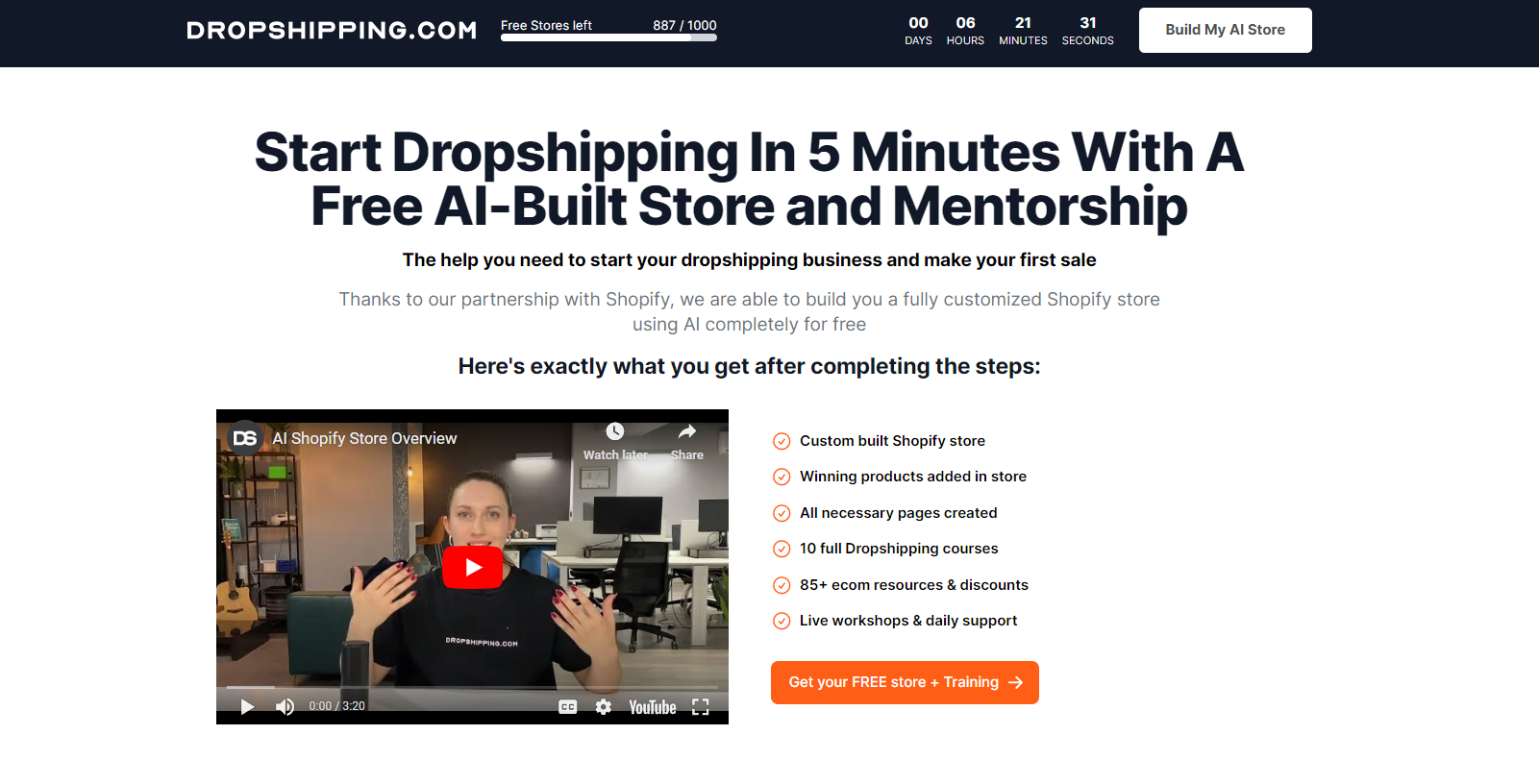
5. Promote Your Store With Free Marketing
To drive organic traffic to your ecommerce store without paying for advertising expenses, consider focusing on SEO and content marketing.
You can use free tools like Google AdWords Keyword Planner or Ubersuggest to find low-competition keywords for your marketing plan.
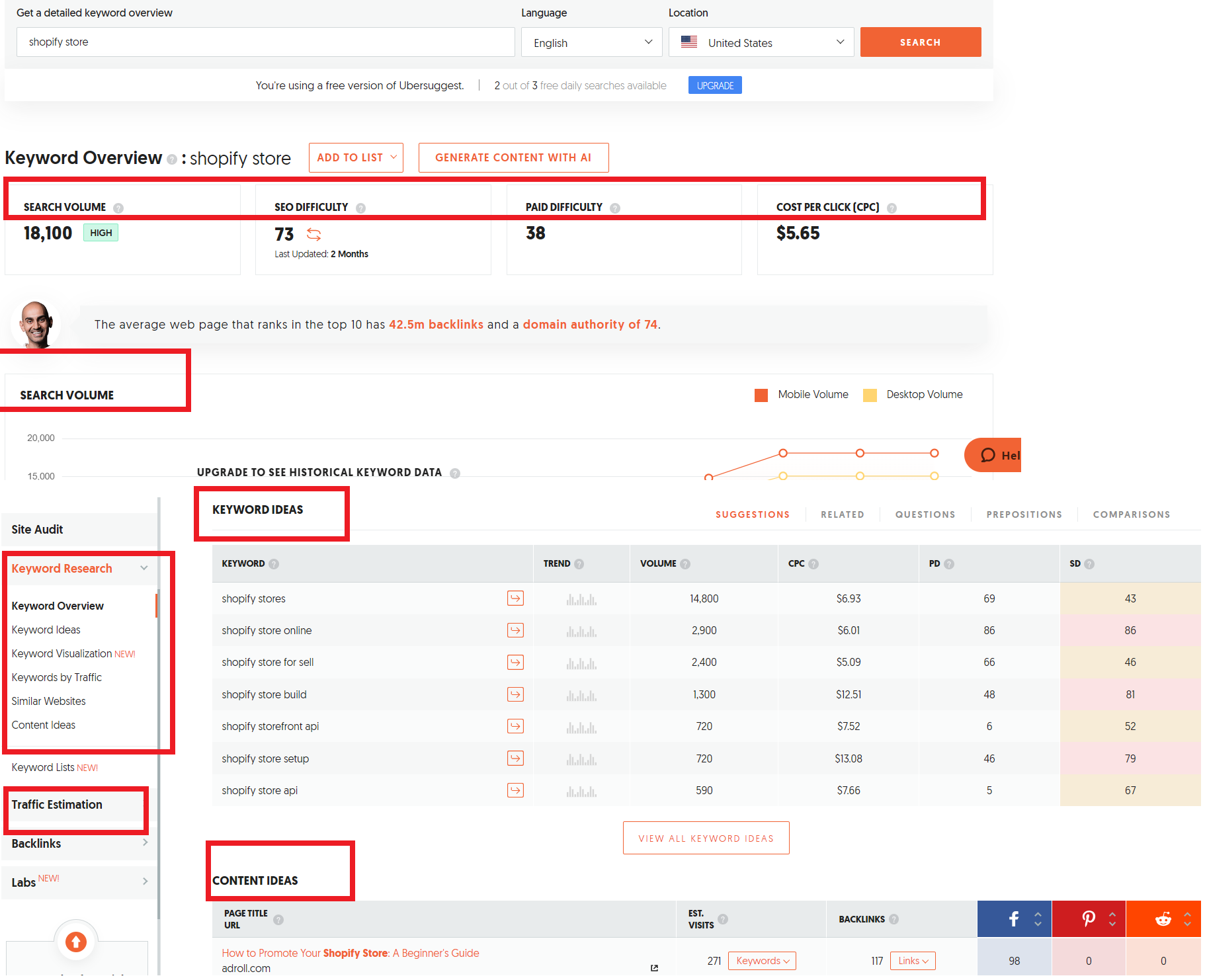
For instance, if you’re selling fitness gear, using keywords like “best fitness accessories for home” can help you rank higher in search engines and attract more potential customers.
You can also leverage influencer marketing and social media to promote your products.
For example, many dropshippers use Instagram to build a following without needing a big marketing budget.
By sharing engaging content and running small ad campaigns, you can effectively drive traffic to your online store.
6. Use Free Dropshipping Software
Managing your dropshipping store is easier with the right tools, and luckily, some are available for free trials or at minimal cost.
For instance, DSers is a great tool for managing orders and automating your dropshipping process, especially when sourcing from AliExpress. They offer a 14-day free trial, giving you enough time to test the software before committing.
AutoDS also provides free trials, helping you streamline operations without paying upfront.
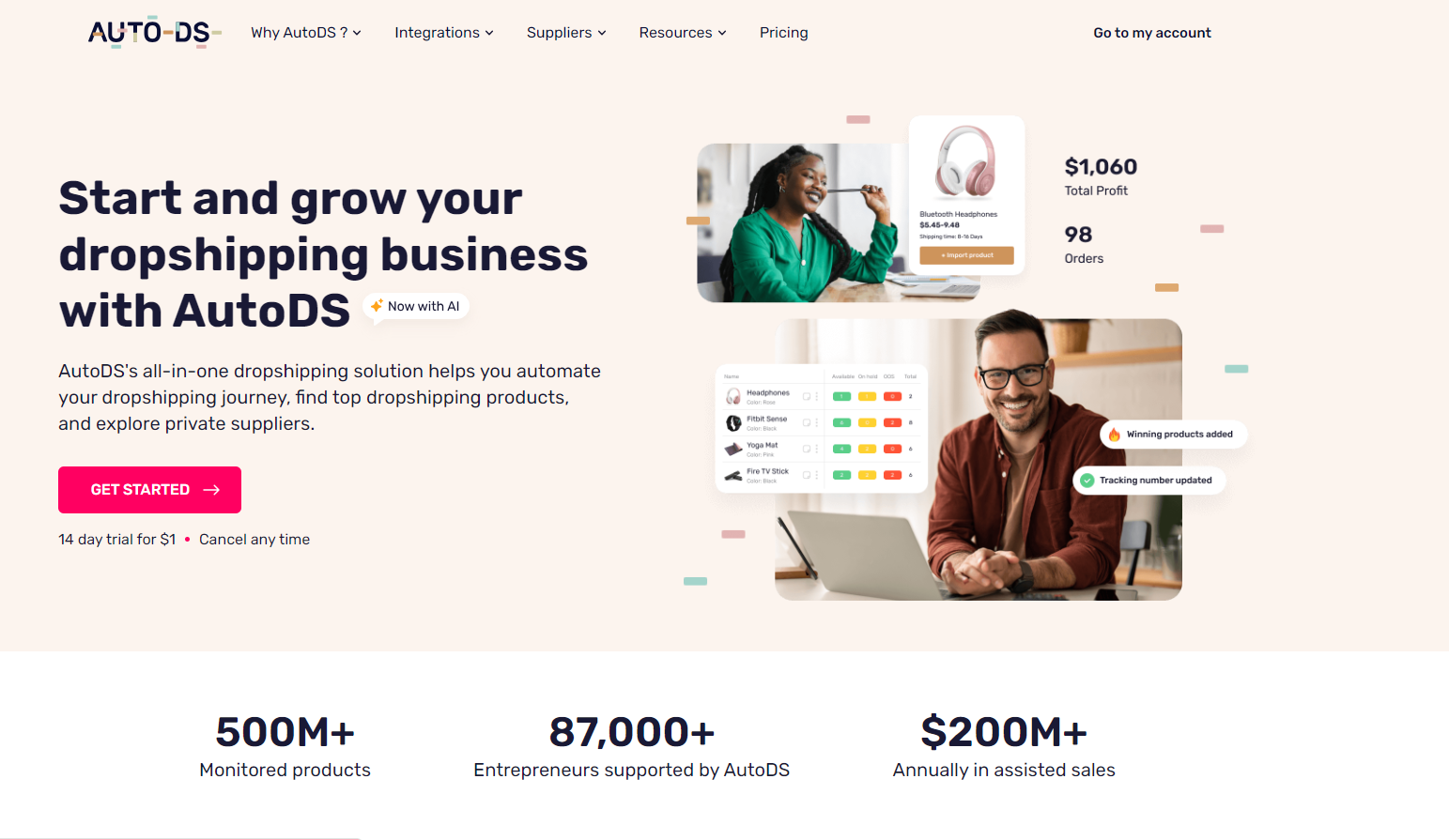
Lastly, a tool like Modalyst connects you with reliable suppliers, giving you access to high-quality products that can help you build a profitable business without spending too much on business expenses.
This platform also integrates with Shopify, allowing you to easily manage your store owners’ tasks like tracking inventory and sales.
👉 How Much Would This Cost You?
- Free trial route: You can start with $0 in the first month by leveraging free trials and free tools.
- Starting monthly costs: After the free trials, the lowest total startup cost would be around $102/month (AutoDS at $19.90 + Shopify at $32 + Ubersuggest at $12 + Sell The Trends at $39).
⚠️ Regulatory Considerations in 2025
New Import Tariffs That Can Affect Your Dropshipping Business
If you’re dropshipping from China or plan to import products into the U.S., there’s a major regulatory update you cannot ignore.
As of May 2, 2025, the United States has introduced a new import tariff policy that significantly impacts small and medium-sized ecommerce sellers—especially dropshippers.
📦 What’s Changing?
Under the new policy, a minimum import fee of 30% now applies to all packages valued under $800 that are shipped from China into the U.S.
This includes products ordered via platforms like AliExpress, Temu, CJdropshipping, and others—even if it’s just one item.
But it doesn’t stop there.
According to multiple discussions on Reddit and trade policy forums, some parcels may be charged as much as $100 per item, or worse, up to 125% of the item’s value—especially for electronics, fashion accessories, and branded-looking products. This makes previously cheap products significantly more expensive and less profitable to dropship.
🛑 What This Means for You as a Dropshipper
If you rely on low-ticket or fast-moving consumer goods from Chinese suppliers, this new rule could:
- Cut your profit margins in half
- Cause unexpected costs at checkout (if not calculated into pricing)
- Result in customer dissatisfaction or order abandonment
- Make “free + shipping” offers nearly impossible to sustain
💡 How To Adapt and Avoid the Tariff Trap
To stay compliant and protect your profit margins, consider these strategies:
- Switch to US or EU-based suppliers whenever possible. Platforms like Spocket, Syncee, and Zendrop’s US warehouse option allow you to ship from domestic warehouses, avoiding international import fees.
- Use local fulfillment centers like ShipBob or Deliverr, where you can pre-stock inventory in the U.S. from Chinese bulk orders, then ship locally.
- Avoid single-item international shipments below $800 from China. Instead, bundle items or shift toward digital products, print-on-demand, or services to bypass physical shipping issues altogether.
- Price your products smartly by factoring in possible duties. Use tariff calculators or contact your suppliers to understand new landed cost structures.
- Explore alternative sourcing countries like Vietnam, India, or Mexico, which may not fall under the same tariff restrictions and can offer competitive rates.
The Best Cost-Effective Shopify Option To Start With Minimum Budget? (My Opinion)
If you are looking to start dropshipping with a minimum budget on Shopify, opting for the Shopify Basic plan can be a highly cost-effective solution.
So, here’s how dropshipping budget 2025 goes:
This plan offers a range of features, including an online store, a secure shopping cart, unlimited product listings, and 24/7 customer support.
Moreover, it allows for mobile commerce and offers a wide variety of add-ons to further customize your store. Also, at this moment it costs $32/month. 👇

Furthermore, Shopify charges a transaction fee of 2.9% + 30¢ for each sale made using a third-party payment gateway, such as PayPal. However, with the Basic plan, the transaction fee is reduced to 2.0%, making it an excellent option for businesses on a tight budget.
Next, once you have a large and complex store and need advanced reporting and shipping options, as well as 24/7 support via phone, email, and live chat, it may be time to consider the Shopify Advanced plan.
Also, you will need Shopify apps to support your dropshipping business operations. Therefore, with numerous apps in the Shopify App Store to choose from, you can certainly improve the functionality of your store.

Thus, most of these apps cost around $9.99-$29. Of course, some are less expensive, whereas others cost so much more.
When it comes to Shopify app pricing, it depends on the app and the features it offers. Also, the average cost of a Shopify app is around $20 to $50 per month.
Not only that, but you also have free Shopify themes to customize your store and built-in SEO, which is FREE, of course.
Moreover, if you want to start dropshipping on Shopify, you can also buy a Shopify domain, which can cost you up to around $15/year.
So, what’s your minimum budget to start dropshipping on Shopify?
In my opinion, this would be around $120- $125 per month. Let me explain:
Shopify Costs:
- Shopify Basic Plan: $32/month – This includes your online store, secure checkout, unlimited product listings, and 24/7 customer support.
- Shopify Domain: Approximately $15/year, or $1.25/month.
Essential Shopify Apps For Dropshippers:
To efficiently manage your dropshipping business, you’ll need a few essential apps. Here’s what to consider:
- DSers (for product sourcing and order fulfillment):
Free basic plan or paid plans starting at $19.90/month. Let’s budget $19.90/month for its robust features. - Conversion Rate Optimization App ( such as Upsell Recommendations):
Apps like ReConvert Upsell or similar start at around $7.99/month for basic features. - SEO Optimization App (like Plug in SEO):
Costs around $20/month to improve your store’s search engine rankings. - Email Marketing App (like Klaviyo or Privy):
Free for basic plans or starting at $10-$20/month for more advanced tools. Let’s include $10/month for email campaigns. - Reviews App ( for instance, Judge.me):
Basic plan starts at $15/month for showcasing customer reviews.
Transaction Fees:
Shopify charges a 2.9% + $0.30 transaction fee for third-party gateways. If you make 10 sales per month at $50 each, you’ll spend around $17.50/month on transaction fees.
Total Monthly Budget:
- Shopify Basic Plan: $32
- Domain: $1.25
- DSers: $19.90
- Upsell App: $7.99
- SEO App: $20
- Email Marketing App: $10
- Reviews App: $15
- Transaction Fees (for 10 sales): $17.50
Final Monthly Budget: $123.64
So, if you are asking is dropshipping expensive this mostly depends on what you use and how you allocate your resources. The example from above is one of the cheapest ways to start dropshipping.
Is Dropshipping Worth It in 2025?
Absolutely—dropshipping is still worth it in 2025, and the numbers prove it.
According to The Business Research Company, the global dropshipping market is expected to reach $442.61 billion by 2025, growing at a rapid CAGR of 24%.
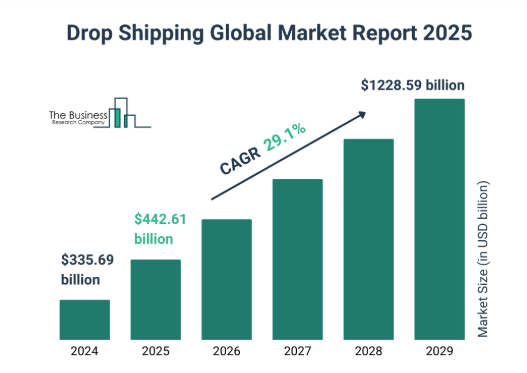
This expansion is backed by booming eCommerce sales, projected to hit $4.32 trillion worldwide in 2025. With low startup costs, no inventory holding, and countless product niches to explore, it’s still one of the easiest ways to launch an online business.
However, success isn’t automatic. In 2025, it’s no longer about throwing up a general store and hoping for the best. It’s about niching down, building a recognizable brand, and using smart tools—like Google Trends—to spot rising demand before the competition.
For example, a simple Trends search for terms like “LED dog collar” or “kitchen organizer” can help you validate if a product is peaking in interest.
So, is it worth it? If you’re willing to treat it like a real business—do your research, test products, and build long-term value—then yes, dropshipping in 2025 is still a highly profitable path.
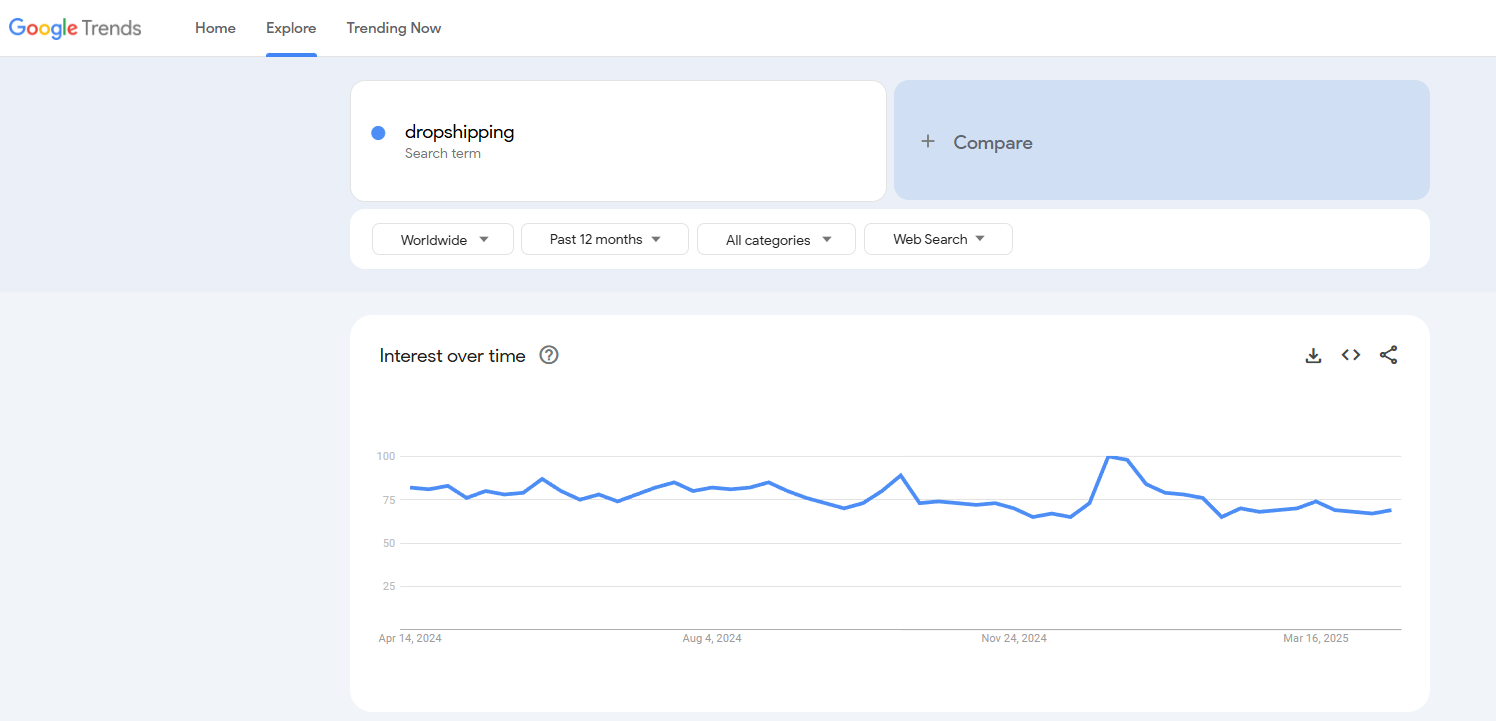
How Much Does It Cost To Start Dropshipping in 2025 – FAQs
1. What is the minimum budget required to start dropshipping in 2025?
2. Is it possible to start dropshipping with no money at all?
3. How much should I budget for advertising when starting out?
4. What are the ongoing monthly costs for a dropshipping store?
5. Are there any hidden costs I should be aware of?
6. How do the 2025 import tariffs affect dropshipping?
7. Is dropshipping still worth it in 2025?
Conclusion
In my opinion, starting a dropshipping business in 2025 offers incredible opportunities with minimal risk, but you need to be strategic about your investments.
As we’ve seen, the cost to start dropshipping can vary widely—from as low as $302 for a lean startup to $1,600 for a more scalable operation.
Key factors to consider include business registration, choosing the right dropshipping suppliers, and budgeting for marketing costs like ads or SEO.
Before diving in, be sure to assess your budget carefully and research which tools and suppliers align best with your goals. While starting small is tempting, be prepared to scale and invest more as your business grows.
My advice? Focus on testing products and optimizing your ecommerce platform before spending heavily. This will allow you to understand your market, control your startup costs, and increase your chances of building a successful dropshipping business.













![The Top 21 3PL Companies Compared [2025 List & Guide]](https://images.weserv.nl/?url=https://prod-dropshipping-s3.s3.fr-par.scw.cloud/2024/03/Frame-3922469.jpg&w=420&q=90&output=webp)